-
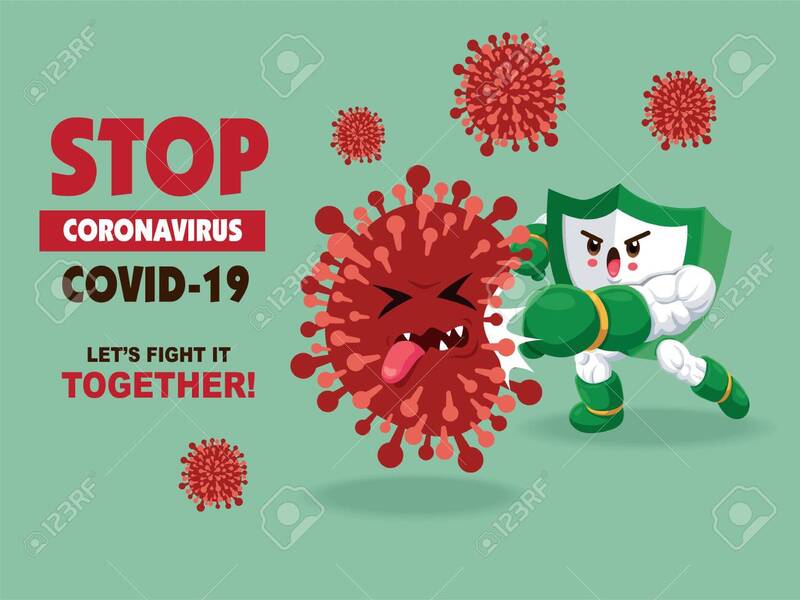
2021-11-17
This particular photo makes me feel like we're taking every effort to help eradicate the spread of covid-19. Although the photo is cartoonish I think that it still sends a great message to get the word out to help stop covid-19 virus. Also letting us know we can all do it together by taking the proper precautions. To help eradicate the spread of covid-19.
-
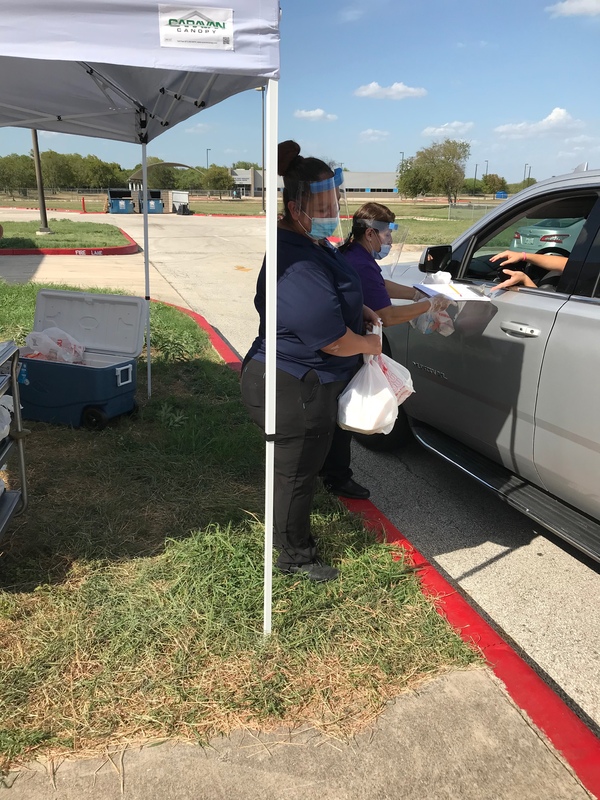
2020-08-12
With the closing of schools, many students no longer had access to a warm and healthy lunch provided by the federal government. Kids from lower income families often rely on school to provide them with at least two meals a day, but because of COVID-19 they no longer could eat certain breakfast like oatmeal and lunch such as, carne guisada, that they have been used to consuming. In order to address this problem, schools began setting up times for parents to come and collect food for their kids three times a day. Ultimately, due to lack of personal time, parents were picking up breakfast, lunch and snacks for three days on Friday.
-
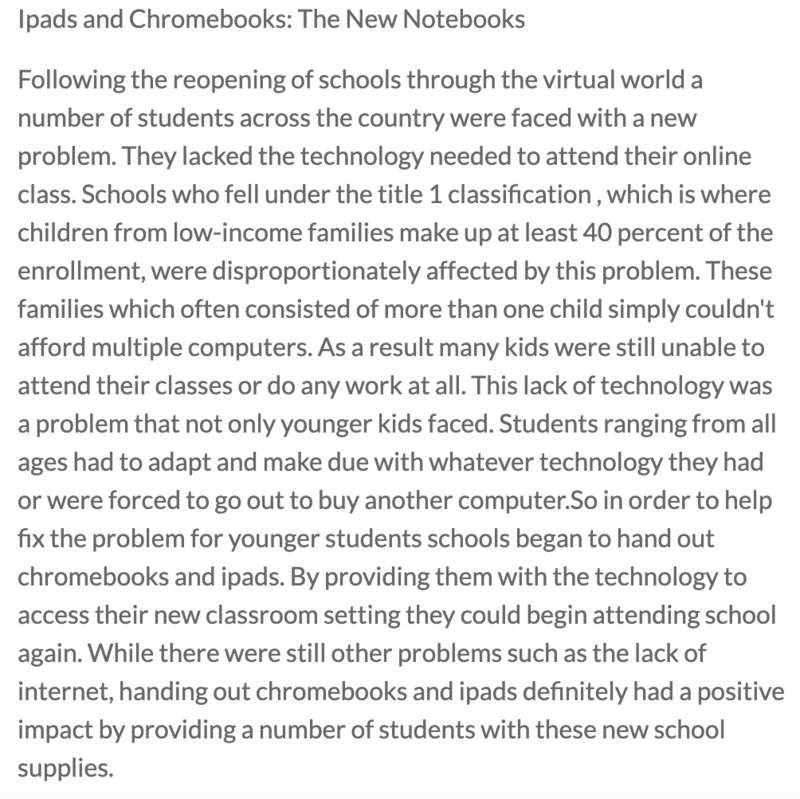
2020-08-11
Following the reopening of schools through the virtual world a number of students across the country were faced with a new problem. They lacked the technology needed to attend their online class. Schools who fell under the title 1 classification , which is where children from low-income families make up at least 40 percent of the enrollment, were disproportionately affected by this problem. These families which often consisted of more than one child simply couldn't afford multiple computers. As a result many kids were still unable to attend their classes or do any work at all. This lack of technology was a problem that not only younger kids faced. Students ranging from all ages had to adapt and make due with whatever technology they had or were forced to go out to buy another computer.So in order to help fix the problem for younger students schools began to hand out chromebooks and ipads. By providing them with the technology to access their new classroom setting they could begin attending school again. While there were still other problems such as the lack of internet, handing out chromebooks and ipads definitely had a positive impact by providing a number of students with these new school supplies.
-
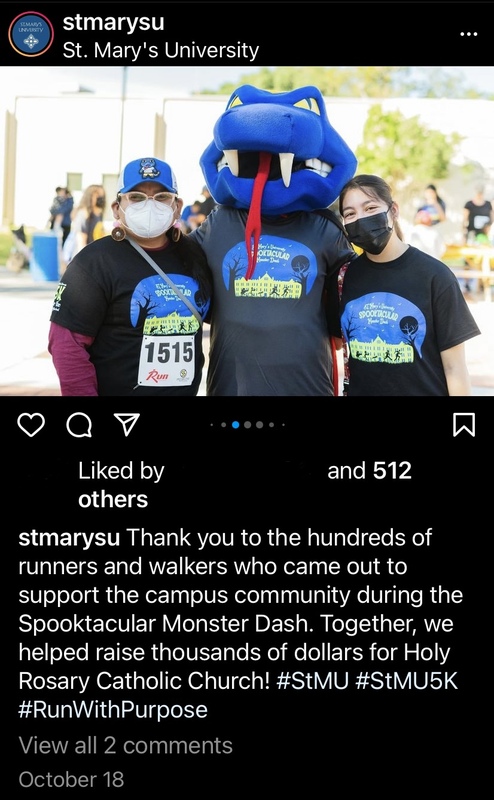
2021-10-18
This screenshot shows an Instagram post from St. Mary's University. The screenshot is in regards to the University's annual marathon for the neighborhood, depicting an in-person event with evidence of masks and other restrictions/changes due to COVID-19. Seeing as the event is back to being held in person, it has both clear similarities and clear differences in respect to the years before, further proving the fact that the pandemic is ongoing and continued adaptation is necessary before we will be able to overcome.
-
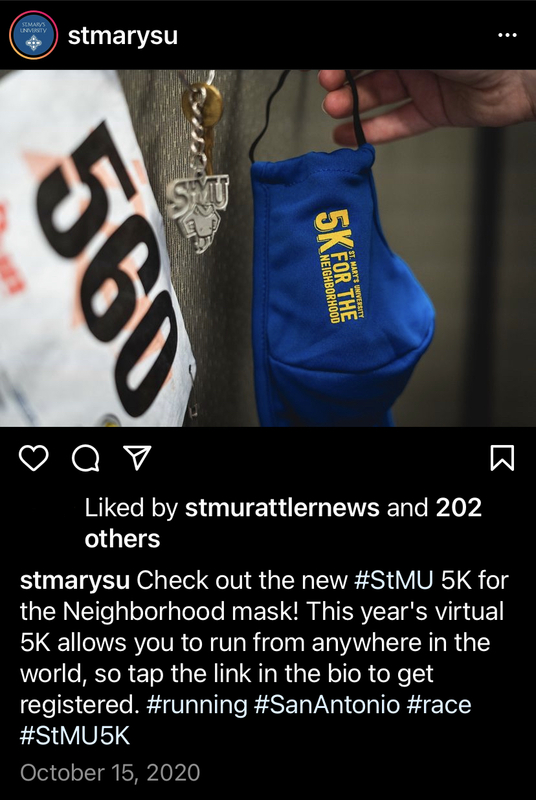
2020-10-15
This screenshot shows an Instagram post from St. Mary's University. The screenshot is in regards to the University's annual marathon for the neighborhood, announcing a virtual marathon this year, that participants can do from anywhere. This is different from the years past, as well as from the years to come, further proving the fact that the pandemic is ongoing and continued adaptation is necessary before we will be able to overcome.
-
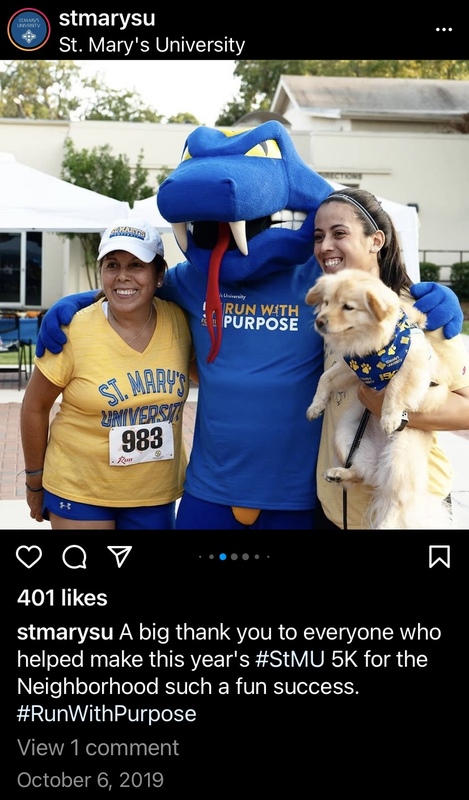
2019-10-06
This screenshot shows an Instagram post from St. Mary's University. The screenshot is in regards to the University's annual marathon for the neighborhood, announcing a virtual awards ceremony. Seeing as this event is clearly being held in-person, with little social distancing and no evidence of masks, it is different from the years before, further proving the fact that the pandemic is ongoing and continued adaptation is necessary before we will be able to overcome.
-
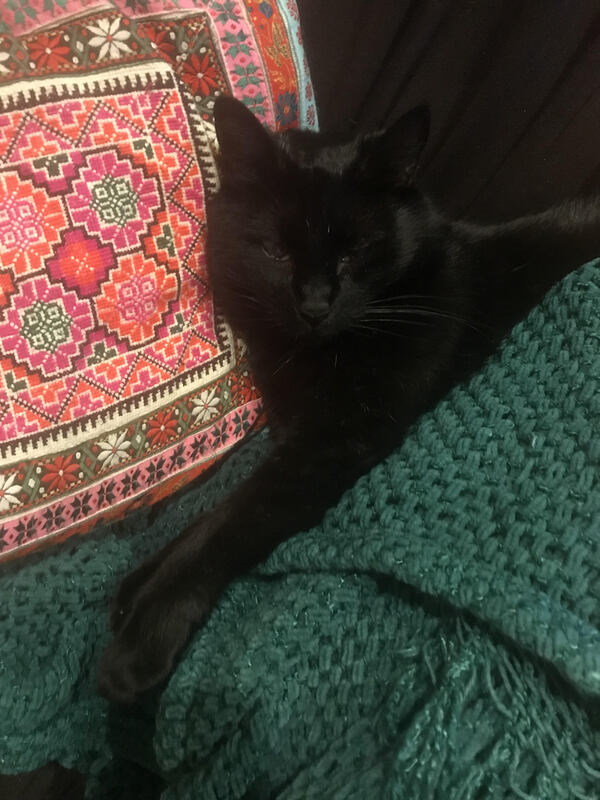
2021-10-01
October 1, 2021, I woke up with a mild headache and a stuffy nose. I didn't think much of it—I had started drinking coffee again and needed a cup, and I’m mildly allergic to my own cats. My headache went away after I had my coffee, and my congestion ceased after I took my Claritin.
After working remotely and basically not socializing for all of 2020 and up through August 2021, I was happy to be out and doing things again. In August, I started working and attending class in-person again, as well as spending time with friends. I still masked up and washed my hands according to guidelines, but it did seem like standards for that were slipping. I take public transit most days, and I’d seen a number of people who either weren’t wearing masks or not wearing them properly. But I still thought I was fairly safe since I followed COVID-19 recommendations, was fully vaccinated, and my campus has an extremely high vaccination rate (100% of students are vaccinated or have exemptions, and 98% of faculty/staff).
So when I woke up experiencing what I thought were symptoms of seasonal allergies, I didn’t think anything of it. I went on a date that afternoon, and then out for drinks with friends later that night. I was very tired when I went home that night, but I chalked it up to how I’d over-committed myself in the initial euphoria of being able to participate in things again. Besides, I was sleeping better than I’d slept in years.
The next day, my congestion was worse and I was coughing. I had an intermittent headache, but I assumed it was just a cold. One of my classmates that I sit next to had had one recently, and she’d tested negative for COVID, so I just assumed I’d picked it up from her.
I remained congested and feeling gross that weekend, enough to call out from my shift on Sunday out of an abundance of caution, but I figured I’d be ready to be back by the time I had class and work again on Wednesday. But Monday afternoon I was working on some of my reading and realized I couldn’t smell the new (and very strong) candle in my living room. To test whether it was just the candle or whether it was me, I sniffed my perfume and finally even put peppermint essential oil right under my nose, and...nothing.
Figuring that it was likely I had COVID at this point, I scheduled a test for the next day. I felt bad about having to get there—was it better to take an Uber or a train/bus? Which was safer for everyone involved? I ended up taking a Lyft, but I left the windows down and made sure I had cough drops so I wouldn’t cough.
Once I arrived at the testing center (where I was the only patient), they got me through quickly and told me they’d be doing PCR testing and I could expect my results within a couple days. I called out of work for the week and let my professors know I likely had it. I woke up on Thursday morning to see my results had arrived, and I had tested positive. I called my school for contact tracing, and they notified the classmates I sit next to and my coworkers.
I texted my friends I’d been out with Friday night and the person I went out with, and it was strange to feel almost ashamed. I had behaved responsibly, but I still felt as though I’d done something wrong in contracting COVID. And I was exhausted, tired of coughing, and just wanted my mom.
I continued to improve, and I felt mostly better by the time my isolation period ended on the 11th. My sense of smell had started to come back, so I wasn’t as worried about a permanent loss there. I was a little concerned by the disregard for no-contact delivery I’d requested when getting food/groceries, but it had mostly been okay. My shifts at work had been given away, even though I was better and out of isolation by then. On the bright side, my cats were thrilled to have had me home that much, so at least it was a good experience for someone.
Everyone I notified directly or via contact tracing tested negative, fortunately. When I started going back to things, I just wanted to scream on the train when I saw people not wearing masks or wearing them improperly. I still do, especially as the number of cases rises.
-
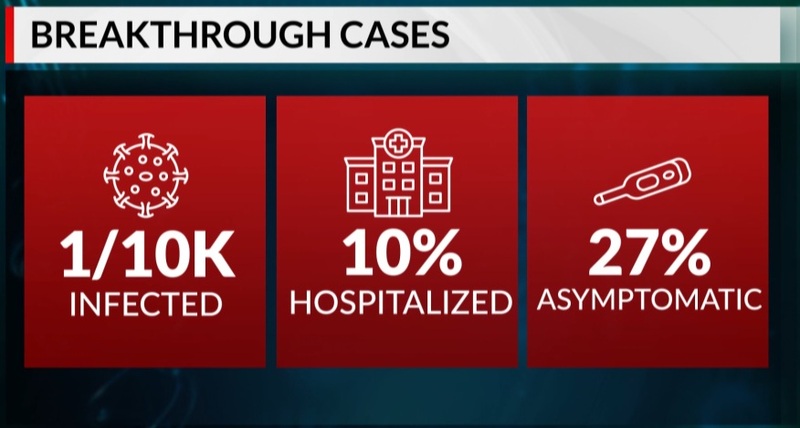
2021-05-25
This graphic shows the rates of infection and hospitalization for breakthrough infections for COVID-19 among vaccinated people (as of May 2021)
-
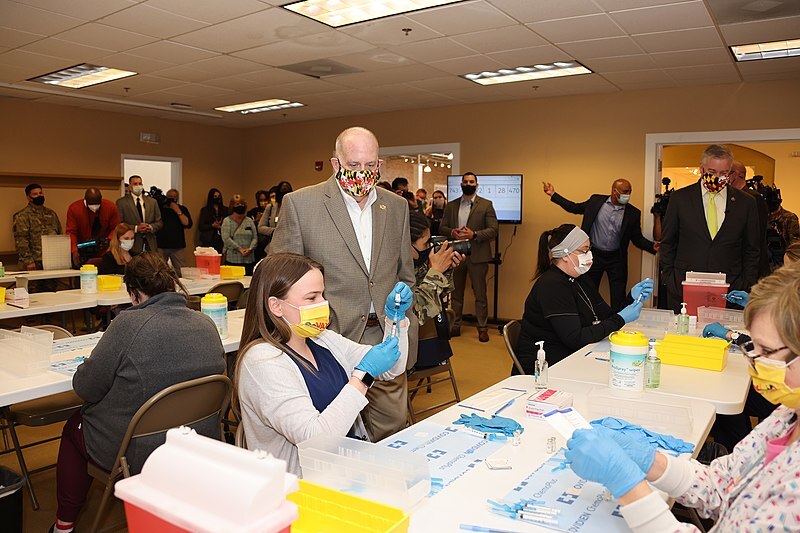
2021-03-26
This photo shows a number of people at a mass vaccination event.
-
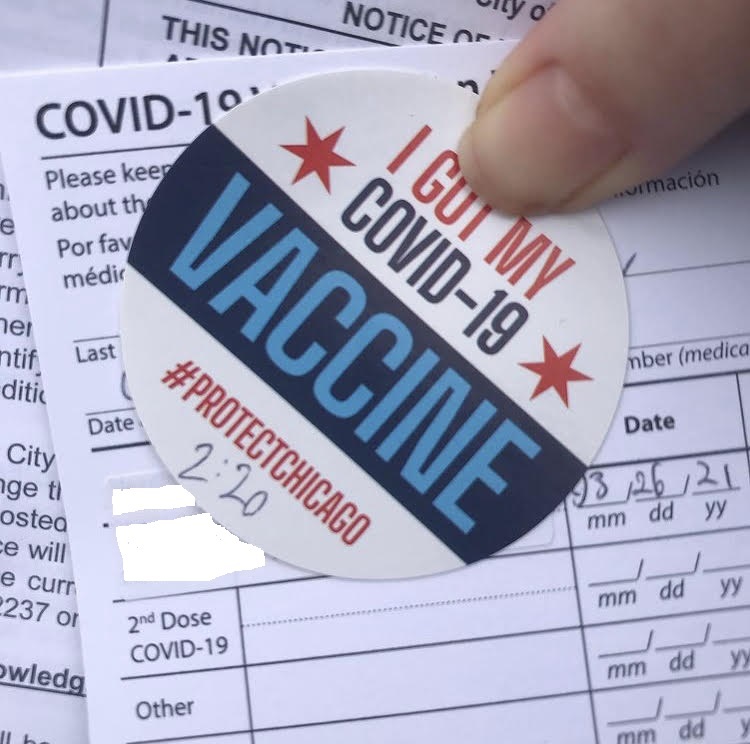
2021-03-26
I was excited to get my vaccine as soon as the FDA approved the Pfizer vaccine. However, as a fairly healthy person who worked remotely, I was by no means going to be the first wave of vaccination. Truthfully, I thought I wouldn’t have a chance to get vaccinated until June or so, and I resigned myself to staying inside.
In early March, I got an email from my school—the United Center was hosting a mass vaccination event, and they had more doses than the original target groups could use. I hurried to sign up. It filled quickly; I had a few friends tell me they were unable to get in. I was lucky, and I went to get my first dose near the end of March.
Supposedly, Uber was offering free rides to/from the United Center (up to a certain amount, at least) for those seeking to get vaccinated. However, I kept getting error messages, so I made my way there by other methods. I panicked since I was almost late to my appointment for the first dose, but my worries faded when I arrived. The clinic volunteers kept the roped off lines going quickly and smoothly, though everyone was kept at least six feet apart. Once you’d been fully signed in—you showed your ID, your appointment voucher, got your temperature taken, and were issued an information packet—you waited to be sent to one of the FEMA people doing the vaccinating. I was called and got my first dose over with quickly and without any fuss, and then I was sent off to the tent where you waited to make sure you didn’t have any adverse side effects within the first 20 minutes. I was fine, so I went home with my vaccination card and instructions to return in 3 weeks.
I returned 3 weeks later (in mid-April), and it went even more smoothly! They had worked out even more kinks, and everyone seemed relieved. While I’d been tired and a little sick a couple days after the first dose, the second one presented no problems.
Later, I learned that a few of my friends were not only also part of the United Center mass vaccination event, but were there on the same days! I didn’t see them, but I’m not surprised given the efficiency of the process.
Over the summer, the United Center’s vaccination program closed after it slowed significantly. So while I will be getting my booster shot soon, it won’t be as part of a mass vaccination endeavor. I’m a little reticent, simply because I don’t know what to expect from going to a pharmacy for it!
-
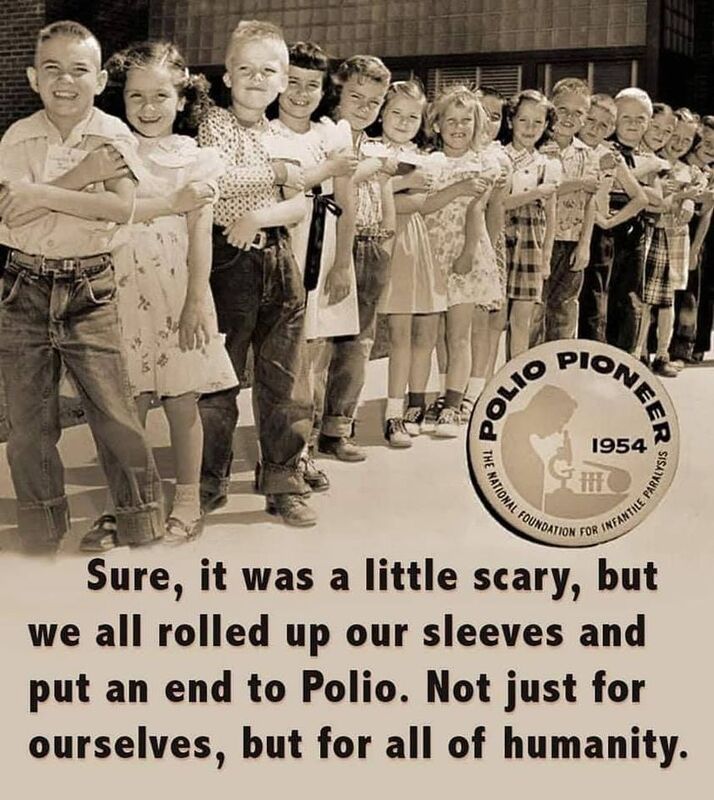
2021-11-13
I have a minimum of 2 resolute anti-vaxxers in my extended family. We try to avoid conflict but sometimes their ignorance is just too much for me to bear and I feel like I have to set the record straight. Here's a summary of what's going on in these screenshots from a FB post.
1. Great aunt posts a meme using the experience of the Polio vaccine to promote the COVID vaccine. (meme included)
2. Anti-vax aunt (orange) posts snarkily that in the case of the polio vaccine, it was only rolled out after 60 years of research.
3. I step in (as a historian of public health) and comment that she's mistaken, the polio vaccine went from lab to roll out in 25 years. While mRNA (on which the COVID vax is based) was first discovered in a lab 35 years ago so it stands to reason that the amount of time between lab and roll out is similar.
4. Meanwhile... anti-vax second cousin (purple- daughter of great aunt who made the original post and also resolutely anti-vax) tags anti-vax aunt (orange) and says "amen." as in... she lends her support
5. Anti-vax aunt (orange) responds to my initial rebuff in #3 and says "wrong. it took 35 years to discover it was a virus" (as if that, added to the 25 years of development constitutes 60 years of "research"
6. I step back in and repeat... polio vaccine research began in 1930, and it rolled out in the US in 1954. Surely she doesn't want to go back to the "good old days" when it took 30 years to discover whether something was a virus, really...??
7. I was wrong. Anti-vax aunt (orangs) DOES want that. She says, "Yes, really"
8. pro-vax cousin (light blue-an oncology NP) comments "Wow. That's sad to think about"
9. Anti-vax aunt (orange): ?
10. pro-vax cousin (light blue): is we were not able to identify viruses like we can today. It's sad to think about all of the people that would die unnecessarily.
This exchange went on but I just don't have it in me to continue with screenshots.
Great aunt (original poster) chimes in and says she doesn't care what people's beliefs are but both of her daughters (one of them the anti-vaxxer in purple) families have COVID right now and she's in her 70s and was exposed to both and never caught it. She firmly believes it's because the vaccine works.
Anti-vax aunt claimed she "didn't post a belief, she posted a fact"
I said "no. you posted an incorrect fact that was skewed to make it look like the polio vaccine underwent 35 more years of research than it actually did and I corrected you."
It's amazing to me that technology that has been in development for 35 years (mRNA) is seen with such suspicion because the virus it's being used with COVID-19 is new. So the assumption is that the vaccine is "untested" even though the technology behind it has a robust research history. I'm even more amazed by people who are anti-covid vaccine even though they had their full slew of childhood vaccines on schedule. I have two very close family members who refused to get vaccinated (different family members than the two distant family featured above) and they had all of their childhood vaccines. One of them even told me she fully expected that everyone who was vaccinated with the COVID vaccine will die in a few years or even "sprout dicks" for all she knows.... yes...
It's imperative that we, as a society, figure out how to address misinformation and disinformation. Certainly, facts/statistics/"Research" are open to interpretation to a degree but much anti-vax info out there is politically motivated. It's not coming from scientists who spend their whole lives studying this stuff.... it's coming from PACs and anti-establishment groups who have beef with the US government and/or "Big Pharma" or Western medicine.
-
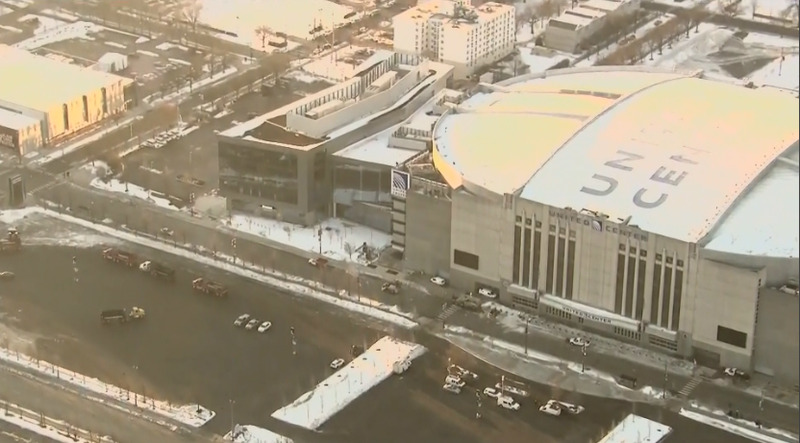
2021-02-26
Parking lots of the United Center will soon host a new mass vaccination site for Illinoisans. Gov. JB Pritzker says the site will have the capacity to give 6,000 doses of vaccine per day.
The home of the Chicago Bulls and Blackhawks will open as a vaccination site on March 10. But, construction is already underway. This will be one of the several community vaccination centers led by the Biden administration. Doses will come directly from the federal government instead of taking vaccine away from the allotment for the state and the city of Chicago.
Leaders explained seniors will have exclusive access to appointments before the site officially opens. However, FEMA hasn’t set dates for those appointments at this time. Reporters asked how Pritzker could guarantee this facility would create easier access for those in need compared to wealthy Chicagoans.
“In the city of Chicago, in Cook County, and across the state, we’ve all made and are continuing to make efforts to attract people of color to people who are most vulnerable to making those appointments, giving them access wherever we can. Having a site in a location like the United Center makes it more easily accessible,” Pritzker emphasized.
Chicago Mayor Lori Lightfoot said rideshare service Uber will provide 20,000 free rides to help people get to the site. Information about scheduling appointments for vaccinations should become available in the coming days.
“With this new site, we’ll now be able to take our vaccination success to a whole new level and bring to bear the historic and inclusive recovery that is soon to come,” Lightfoot explained.
Getting Black and brown residents vaccinated
Still, the state has a significant issue getting Black and Latinx Illinoisans vaccinated. U.S. Sen. Dick Durbin explained a recent study showed minority neighborhoods in Chicago had a vaccination rate of 5%. The majority-white areas of Chicago currently report 13% of the population vaccinated. Durbin says the United Center site should help.
“The faster we can get people vaccinated, the more quickly we can escape the grip that this pandemic has had on our nation for so long, the less likely we’re gonna see mutations and variations which we have to fight in different ways,” Durbin added.
The Springfield native said the federal government could provide more help with vaccine distribution bypassing the American Rescue Plan. President Joe Biden has asked Congress to approve the $1.9 trillion package with specific portions going to mass vaccination sites and $1,400 stimulus checks.
Pritzker noted things are getting better in the long battle with COVID-19.
“Someday not too far from now, we’ll be at the United Center not for a life-saving shot, but for a game-winning shot,” Pritzker said.
-
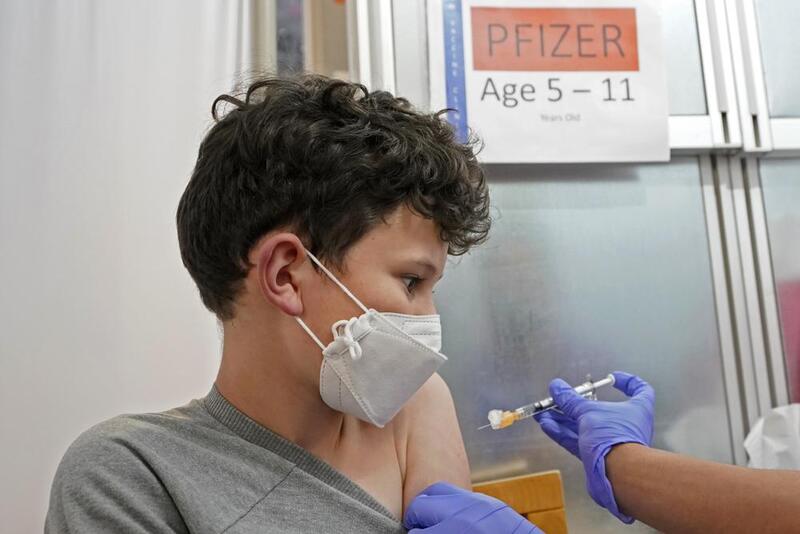
2021-11-10
The campaign to vaccinate elementary school age children in the U.S. is off to a strong start, health officials said Wednesday, but experts say there are signs that it will be difficult to sustain the initial momentum.
About 900,000 kids aged 5 to 11 will have received their first dose of the COVID-19 vaccine in their first week of eligibility, the White House said, providing the first glimpse at the pace of the school-aged vaccination campaign.
“We’re off to a very strong start,” said White House COVID-19 coordinator Jeff Zients, during a briefing with reporters.
Final clearance for the shots was granted by federal regulators on Nov. 2, with the first doses to kids beginning in some locations the following day.
The estimated increase in vaccinations in elementary school age children appears similar to a jump seen in May, when adolescents ages 12 to 15 became eligible for shots.
Now nearly 20,000 pharmacies, clinics and physicians’ offices are offering the doses to younger kids, and the Biden administration estimates that by the end of Wednesday more than 900,000 of the kid doses will have been given. On top of that, about 700,000 first-shot appointments are scheduled for the coming days.
About 28 million 5 to 11 year-olds are now eligible for the low-dose Pfizer vaccine. Kids who get their first of two shots by the end of next week will be fully vaccinated by Christmas.
The administration is encouraging schools to host vaccine clinics on site to make it even easier for kids to get shots. The White House is also asking schools to share information from “trusted messengers” like doctors and public health officials to combat misinformation around the vaccines.
A initial surge in demand for vaccinations was expected from parents who have been waiting for the chance to protect their younger kids, especially before the holidays.
About 3% of newly eligible children in the U.S. got first shots in the first week, but the rate of vaccinations in varied widely around the country, as it has for adult vaccines.
California Health and Human Services Secretary Dr. Mark Ghaly said Wednesday that more than 110,000 Californians ages 5 to 11 have received their first coronavirus shot — 9% of kids that age in the state.
“We are starting to see this pick up and I’m really encouraged about what this means for our state,” Ghaly said.
On the other ends of the spectrum, Idaho reported just 2,257 first shots, or 1.3% of the newly eligible kids there.
In West Virginia’s Cabell County, high demand led local health officials to start setting up vaccination clinics in all the county’s public middle schools. A spokeswoman for the county health department said there were some lines for vaccines in the first few days after the doses were approved for kids ages 5 to 11, but that things have slowed since then.
Some experts say that nationally, demand could also begin to recede soon. They note polling data suggests only a fraction of parents have planned to get their kids shots immediately, and they suspect the trend will play out like it did earlier this year when kids ages 12 to 15 were first able to get shots.
In the first week after vaccines for that age group were authorized in May, the number of adolescents getting a first shot jumped by roughly 900,000, according to an American Academy of Pediatrics review of federal data. The next week, it rose even further, to 1.6 million.
“There was an initial burst,” said Shannon Stokley of the Centers for Disease Control and Prevention.
But then the number dropped steadily for months, interrupted only briefly in early August as the delta variant surged and parents prepared to send children back to school.
Adolescent vaccinations have since flagged considerably, to just 32,000 getting their first shots last week. Only about half of adolescents ages 12 to 17 are fully vaccinated, compared to 70% of adults.
It’s unlikely that vaccination rates in young kids will be as high as what’s seen in adults — or even in adolescents, some experts said, unless they are required for school.
Part of the reason is that adults are far more likely than children to suffer serious illness or die from COVID-19, they noted. “Parents may have the perception it may not be as serious in young children or they don’t transmit it,” said Stokley, the acting deputy director of the CDC’s Immunization Services Division.
But more than 2 million COVID cases have been reported in U.S. children ages 5 to 11 since the pandemic started, including 66 deaths over the past year, according to CDC data. “We’re going to have a lot of work to do to communicate to parents about why it’s important to get children vaccinated,” she said.
Zients said the effort to vaccinate younger kids is still ramping up, with new clinics coming on line. Government officials expect the number of children who are vaccinated to keep rising in the days and weeks ahead, he said.
“We are just getting started,” he said.
Earlier this year the White House set — and missed — a July 4 goal to have at least certain percentage of U.S. adults vaccinated. Officials have not announced a similar target for kids.
Dr. Lee Savio Beers, president of the American Academy of Pediatrics, called the new numbers reassuring and said the rollout appears to be going smoothly for the most part. She noted however that with a lower dose and different vials than for older kids, the rollout requires more steps and that some states have been slower in getting vaccine to providers.
Initial data from some areas show Black children lagging behind whites in getting their first doses, which Beers said raises concerns.
“It’s really important to make sure the vaccine is easily accessible in a wide variety of places,” Beers said.
-
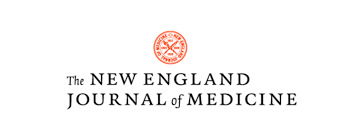
2021-09-16
Vaccine safety is critical for the successful implementation of any vaccination program, especially during a pandemic. In February 1976, the Centers for Disease Control and Prevention confirmed a cluster of cases of severe influenza-like illness among Army recruits at Fort Dix, New Jersey.1 A swine influenza A strain that resembled the 1918 pandemic influenza strain was identified,2 and a vaccination program was subsequently initiated for the entire U.S. population. After more than 40 million persons were vaccinated, a small excess risk of Guillain–Barré syndrome was noted, with an attributable risk of approximately 1 case per 100,000 doses administered. Given these concerns and because the pandemic did not materialize, the vaccination program was halted in December 1976 so that the issue could be explored further. This experience shed light on the need for real-time vaccine safety surveillance and the importance of context in decision making during a pandemic.
In a study now reported in the Journal by Barda et al., the investigators simultaneously evaluated the risk of adverse events among persons (≥16 years of age) who had received the BNT162b2 vaccine (Pfizer–BioNTech) and the risk of the same events after severe acute respiratory syndrome coronavirus 2 (SARS-CoV-2) infection.3 The authors used data from the largest integrated payer–provider health care organization in Israel, in conjunction with data on SARS-CoV-2 polymerase-chain-reaction tests and data on coronavirus disease 2019 (Covid-19) vaccine administration from the Israeli Ministry of Health.
This use of multiple data sets highlights the importance of investment in digital capabilities and meaningful integration across systems in order to provide real-time answers to key public health questions. The design of rigorous postauthorization vaccine safety studies during the Covid-19 pandemic has been a challenge because the pandemic itself has caused changes in health care utilization, the rollout of Covid-19 vaccines has occurred in phases because of initial supply limitations, and there have been disparities in access to vaccines. Barda et al. broadly addressed many of these challenges by emulating a trial that matched eligible vaccinees to unvaccinated controls according to sociodemographic characteristics, the number of preexisting chronic health conditions, previous health care utilization, and pregnancy status.
In the vaccination analysis, the study included 42 days of follow-up (i.e., 21 days after the first dose and 21 days after the second dose). This analysis accounted for seasonal and secular trends by matching on the day of vaccination, rather than relying on historical risk estimates that may not have been comparable in the pandemic setting. In the SARS-CoV-2 analysis, a similar approach was used to match persons with a newly diagnosed infection to uninfected persons.
Although the risk estimates in the vaccination and the SARS-CoV-2 analyses were not directly comparable because of differences in the populations (i.e., events were evaluated per 100,000 vaccinated persons and per 100,000 infected persons, respectively), these risks were placed in context. The most salient example is myocarditis, which has received much attention recently given the preponderance of reported cases after vaccination among adolescents and young adults and the incidence of myocarditis observed after SARS-CoV-2 infection.4-6 In the population-based cohort in the study conducted by Barda and colleagues, the risk ratios for myocarditis were 3.24 (95% confidence interval [CI], 1.55 to 12.44) after vaccination and 18.28 (95% CI, 3.95 to 25.12) after SARS-CoV-2 infection, with risk differences of 2.7 events per 100,000 persons (95% CI, 1.0 to 4.6) and 11.0 events per 100,000 persons (95% CI, 5.6 to 15.8), respectively. What is even more compelling about these data is the substantial protective effect of vaccines with respect to adverse events such as acute kidney injury, intracranial hemorrhage, and anemia, probably because infection was prevented. Furthermore, the persons with SARS-CoV-2 infection appeared to be at substantially higher risk for arrhythmia, myocardial infarction, deep-vein thrombosis, pulmonary embolism, pericarditis, intracerebral hemorrhage, and thrombocytopenia than those who received the BNT162b2 vaccine.
National discussions about benefit–risk balance often focus on the benefits of preventing symptomatic disease, hospitalization, or death due to Covid-19 and the risks of serious adverse events after vaccination.7,8 As specific adverse events such as myocarditis are highlighted, however, the lack of corresponding specificity about benefits can hamper efforts to communicate effectively with patients. Messenger RNA (mRNA) vaccines may be associated with myocarditis, but they can also prevent cases of myocarditis, acute kidney injury, arrhythmia, and thromboembolic disease. The key to comparing these risks depends on the risk of SARS-CoV-2 infection to an individual person, and that risk can vary according to place and over time. Given the current state of the global pandemic, however, the risk of exposure to SARS-CoV-2 appears to be inevitable.
One major limitation of this study is the lack of risk estimates according to age group and sex. For example, thrombosis with thrombocytopenia syndrome occurs predominantly in young adult women who have received adenoviral vector vaccines against SARS-CoV-2, whereas myocarditis predominantly occurs in male teens and young men who have received mRNA vaccines.5,9,10 Age- and sex-stratified comparisons that reflect local epidemiologic factors might support public understanding of different approaches to vaccine use in different countries, such as Israel, the United Kingdom, and the United States. Other limitations of the study include the paucity of data regarding younger teens and children, the conservative assumption that vaccines have no effect on transmission, and the absence of medical record review to validate computable phenotypes (i.e., algorithms used to identify a cohort on the basis of patient records).
As new knowledge of the safety and benefits of vaccines continues to evolve, studies like this one may help to support decision making about the use of Covid-19 vaccines. The benefit–risk balance should be reassessed, refined, and communicated as the disease burden changes, new variants and safety signals emerge, and vaccine effectiveness begins to wane. Context matters, which means that we as a country need to be ready for continual learning and change.
-
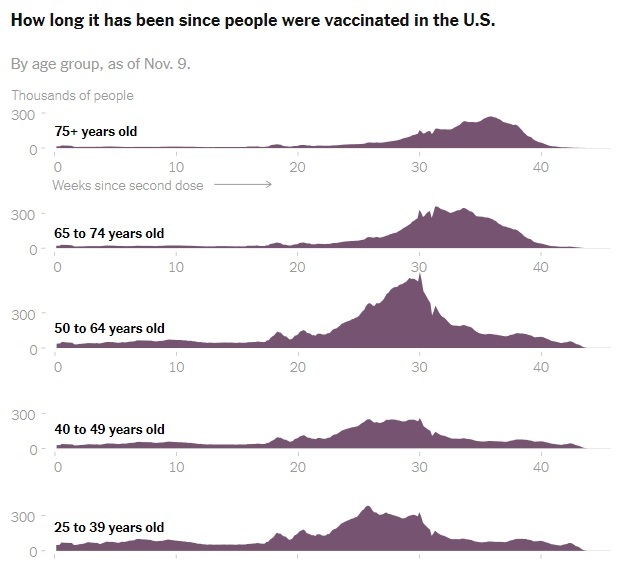
2021-11-11
As tens of millions who are eligible in the United States consider signing up for a Covid-19 booster shot, a growing body of early global research shows that the vaccines authorized in the United States remain highly protective against the disease’s worst outcomes over time, with some exceptions among older people and those with weakened immune systems.
But while the vaccines’ effectiveness against severe disease and hospitalization has mostly held steady, even through the summer surge of the highly transmissible Delta variant, a number of published studies show that their protection against infection, with or without symptoms, has fallen.
Public health experts say this decline does not mean that the vaccines are not working.
In fact, many studies show that the vaccines remain more than 50 percent effective at preventing infection, the level that all Covid vaccines had to meet or exceed to be authorized by the Food and Drug Administration back in 2020. But the significance of these declines in effectiveness — and whether they suggest all adults should be eligible for a booster shot — is still up for debate.
-

2020-06-30
It is Summer 2020 and students nationally, and even internationally, are preparing themselves to live on campus. For some, it is their first time, and for others, they are returning to their home away from home. However, it is a new experience for both as they adjust to the new rules and regulations of living on campus. This email from the President of St. Mary's University was sent to all Rattlers and is symbolic of the changes students had to adapt to in order to live on campus.
-
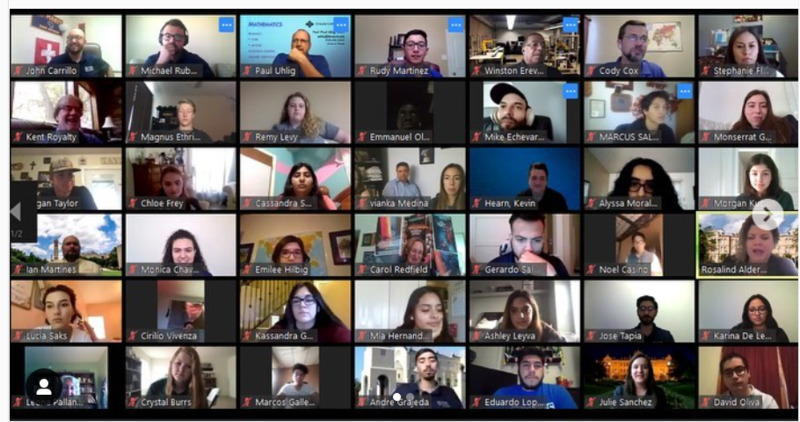
2020-05-13
The pandemic hit and many new college students were forced to enjoy their admission celebrations from their homes through their computer screen and Zoom. Still, St. Mary's University pushed forward to make this event memorable and celebrate future incoming Rattlers to their new school. This screenshot is a still shot of the emotions and celebrations early freshmen experienced during the pandemic. Being accepted into university is no small thing, but a Zoom celebration is a small gesture of congratulations that feels very big.
-

2021-08-05
The meal voucher was made for international students coming during the first weekend of August and did not have food, nor was the cafe open for them to eat. During the summer of 2021, communication between the University Cafeteria and the Center for International Programs was complex due to changes inside the Center for International Programs. No plans were made for the incoming students coming that weekend. For that reason, the Center for International Programs had to create a meal voucher to eat at Starbucks or Chick-fil-a inside the campus. Twenty students were coming in the weekend, and the CIP team had to check them in, bring food supplies, and pick them up from the airport.
-
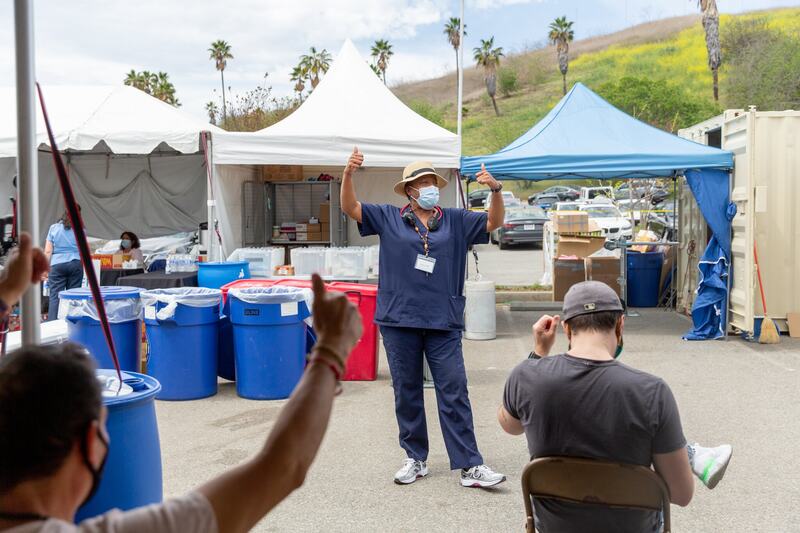
2021-04-06
President Biden will promote his administration’s success in accelerating the pace of coronavirus vaccinations during two appearances on Tuesday, as officials in nearly every state say they will make shots available to all adults by his target of April 19.
Three months into his presidency, Mr. Biden confronts an escalating migrant surge at the border with Mexico and has embarked on a grind-it-out effort to ram through a $2.3 trillion infrastructure bill. But the virus remains his primary focus.
And he wants the country to know that — so he is offering multiple updates each week, along with helpful visual cues, like standing next to a giant Easter bunny wearing a mask.
On Tuesday afternoon, Mr. Biden will travel to Alexandria, Va., to tour a vaccination site at the Virginia Theological Seminary. Later, at the White House, he will deliver remarks emphasizing recent successes, including the milestone of delivering four million vaccinations in one day over the weekend.
More than three million doses are now being given on average each day, compared with well under one million when Mr. Biden took office in January, according to the Centers for Disease Control and Prevention. Every state has now given at least one dose to a quarter or more of its population. About 62.4 million people — 19 percent of Americans — have been fully vaccinated.
On Monday, Gov. Larry Hogan of Maryland announced that all Maryland residents 16 or older would be eligible from Tuesday for a shot at the state’s mass vaccination sites, and starting April 19 at any vaccine provider in the state.
Also on Monday, Gov. Philip D. Murphy of New Jersey and Mayor Muriel Bowser of Washington, D.C., said residents 16 or older would be eligible on April 19.
Gov. Kate Brown of Oregon announced Tuesday that all Oregonians over the age of 16 were eligible to receive a vaccine. The state had been limiting the doses to those with underlying conditions and frontline workers.
That leaves one state, Hawaii, keeping to Mr. Biden’s original deadline of May 1.
In Hawaii, 34 percent of residents have received at least one dose. Alabama has vaccinated the lowest proportion of its residents, at 25 percent.
Along with dangerous coronavirus variants that were identified in Britain, South Africa and Brazil, new mutations have continued to pop up in the United States, from California to New York to Oregon.
The shots will eventually win, scientists say, but because each infection gives the coronavirus a chance to evolve further, vaccinations must proceed as quickly as possible.
For now, however, cases are rising sharply in parts of the country, with some states offering a stark reminder that the pandemic is far from over. Yet again, governors across the country have lifted precautions like mask mandates and capacity limits on businesses.
-
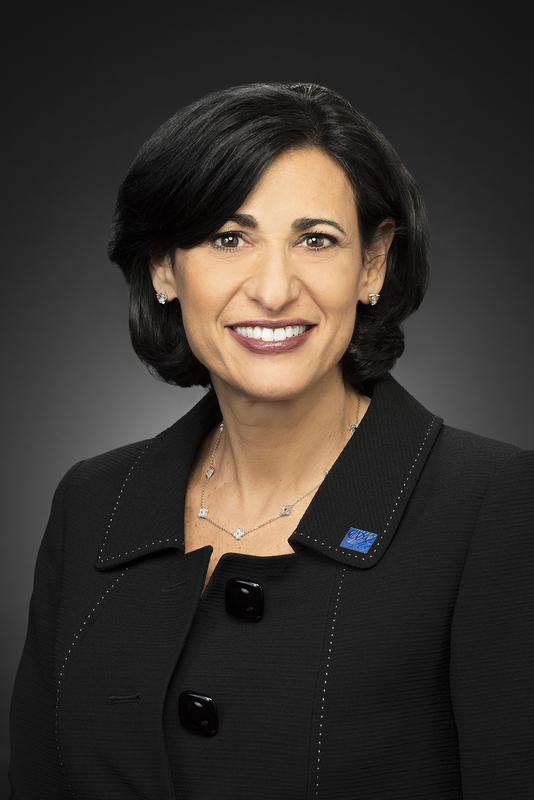
2021-01-19
As Rochelle Walensky, MD, MPH, prepares to assume the role of CDC director on January 20, the former professor of medicine at Harvard Medical School and infectious disease physician at Massachusetts General Hospital and Brigham Women’s Hospital faces a myriad of challenges wrought by the ongoing coronavirus disease 2019 (COVID-19) pandemic.
January 21st marks the 1-year mark since the first case of COVID-19 was reported in the United States, while current data indicate the country has surpassed 400,000 deaths. In comparison, the 1918 flu pandemic took 675,000 American lives, while the US reported a total of 405,000 fatalities during World War II.
Even at the unprecedented speed with which pharmaceutical companies have developed vaccines for COVID-19, rollout has been fragmented at the state level while racial disparities in administration rates are beginning to become apparent.
In an effort to improve the national rollout of COVID-19 vaccines, Walensky plans to increase the CDC’s communication to combat any hesitancy in receiving the vaccine, and indicated she wanted to increase media appearances above those made by current director Robert Redfield, MD, who departs with any remaining Trump administration officials Wednesday. She said making sure science-based communication is effectively disseminated to the public in layman’s terms is a top priority.
“Science is now conveyed through Twitter. Science is conveyed on social media, on podcasts, and in many different ways. And I think that's critical,” Walensky said during a livestreamed interview with JAMA's Howard Bauchner, MD, the journal's editor-in-chief. When confronting vaccine hesitancy or anti-vaxxer sentiment on social media, “There's just this massive void and the right information, I think, is not getting out there… I want to make sure that the science is conveyed. We have to say it to one another. We have to say it to the public. And then we have to say it in other forms.”
Internally, Walensky hopes to bolster the voices of scientists already employed by the CDC. Under the Trump presidency, “they have been diminished. I think they've been muzzled,” Walensky said. “This top tier agency—world renowned—hasn't really been appreciated over the last 4 years, and really markedly over the last year. So I have to fix that.”
Although some states have been widely successful in administering the allotment of COVID-19 vaccines they were given, many have reported roadblocks. Part of the Biden administration’s plan to enhance rollout is to expand vaccine allocation to 4 key locations: federally qualified health centers, community vaccination centers (ie, stadiums), mobile units, and pharmacies.
“Part of the challenge with COVID-19 was that we had a frail public health infrastructure to start. It wasn't ready to tackle what it was given,” Walensky said. As director, she hopes to bring this reality to Congress’ attention. “We're in this because we had warnings for many, many other public health scares in the last 20 years and we didn't fix our public health infrastructure and our data infrastructure,” in response to those tests.
In order to meet President-elect Biden’s goal of 100 million vaccinations in 100 days, the constraints currently faced by federal and state governments need to be mitigated. “We have to titrate our supply and our eligibility so that we somehow hit the sweet spot, wherever it is we are, with how much supply we have and how many people are eligible,” Walensky said.
While the CDC set the initial guidelines for vaccine eligibility and revised them this month, the Trump administration left actual rules and distribution processes to states, resulting in wide variation across the country. Some states adopted stricter standards that led to the waste of vaccines, while loose adherence has led to long lines and confused residents.
Expanding the population of those eligible to administer the vaccine can also help alleviate these roadblocks. These individuals can include retirees, the Public Health Commissioned Corps, medical military, upper level medical and nursing students, dentists and veterinarians.
Increasing both the number of vaccination sites and vaccinators will also help address the equity problems brought to light by the pandemic. “We want to make sure that we can deliver volume, but also volume to the people in places that might be harder to reach.” In a collaborative approach, the federal government will step in at a state-by-state level and offer help based on each state’s unique challenges, Walensky said.
-

2020-12-31
Logistical problems at the heart of the federal government’s faltering rollout of coronavirus vaccines came into sharper view Thursday as the Trump administration fell vastly short of its goal of delivering an initial shot to 20 million people by the end of December.
On the final day of a bleak year, only about 2.8 million people had received the shot, according to the Centers for Disease Control and Prevention — the first of two doses needed to provide immunity to the virus. Around 14 million doses had been distributed as of Wednesday, according to Gustave Perna, chief operating officer of Operation Warp Speed, and a total of 20 million doses have been allocated.
Though the figures are an underestimate — data collection on vaccinations has lagged — the doses administered so far represent just a small fraction of the ambitious targets outlined by officials from the administration’s Operation Warp Speed program in the fall.
“We’d have liked to have seen it run smoothly and have 20 million doses in to people today, by the end of 2020, which was the projection,” Anthony S. Fauci, the government’s leading infectious-disease expert, said in an interview with NBC’s “Today” show on Thursday. “Obviously it didn’t happen, and that’s disappointing.”
Nationwide, states and health-care providers continued to grapple with unpredictable timelines for when new vaccine shipments would arrive and in what quantities, while chronically underfunded public health departments struggled to muster the resources to carry out mass injections of front-line workers and vulnerable people.
Fauci said that he hoped momentum for vaccinations would build in the first weeks of the new year and bring the country closer to its immunization goals.
“But there really has to be more effort in the sense of resources for the locals, namely the states, the cities, the counties, the places where the vaccine is actually going into the arms of individuals,” he said. “We have to support the local groups, the states and the cities to help them get this task done, which is a very prodigious task.”
Under the Trump administration’s plan, the federal government supplies vaccines to states but leaves it to state officials to prioritize residents, send doses to providers and get shots into people’s arms.
The approach — as well as a litany of logistical problems — has caused a varied distribution effort. Local health departments and hospitals tasked with administering the vaccines have complained that they do not know when shipments will come or if they will receive additional resources, said Oscar Alleyne, and epidemiologist and chief of programs and services for the National Association of County and City Health Officials, which is made up of about 3,000 local health departments.
“Some health departments have only received vaccines as recently as this week,” Alleyne told The Washington Post. “I had one health department that told me they had received their vaccines the day after Christmas.”
Alleyne compared the communication concerns to those that cropped up during the H1N1 pandemic in 2009, when unclear guidance hampered efforts to get the population vaccinated.
“It really boils down to ensuring a very transparent process,” Alleyne said.
“There will always be a lag between the doses allocated and those shipped; between those shipped and those administered; and between those administered and those reported to CDC as administered,” Michael J. Pratt, a spokesperson for Operation Warp Speed, said in a statement. “We’re working to make those lags as small as possible.”
At the Texas Medical Center, the largest medical complex in the world, the approach has already created logistical challenges. Hospital officials on the campus in south Houston often don’t know exactly when to expect new shipments or precisely how many vials they’ll receive, according to Bill McKeon, the center’s chief executive officer. That leaves the center with just a couple days’ worth of vaccine inventory on hand at a time, he said.
“At best, we hear estimates. It’s a day-to-day situation,” McKeon told The Post. “We hear that we may be getting more next week but we’re not sure.”
To date, the center has administered the first of the two injections to about 60,000 people, averaging more than 4,000 a day, according to McKeon. That includes some of the center’s 120,000 employees, as well as patients with underlying conditions who are first in line for inoculation. But it’s only a tiny portion of the sprawling metropolitan area the center serves.
Until hospital officials can better predict how many vaccine doses they’ll have available week after week, McKeon said, vaccinating more people, faster, will be an uphill battle.
“You can’t do scheduling with a couple days of inventory. We wouldn’t put a patient through the process of coming to the hospital, leaving their home, and then say, ‘Sorry we don’t have the inventory,’ ” he said. “We can’t be bold and just say, ‘Let’s do ten thousand a day.’ ”
McKeon called on the federal government to take a more active role, possibly offering more large-scale vaccination centers, and relieve pressure on state officials, whom he said were “rowing in the same direction” as providers. There will be a growing need not just for more health-care workers to give the shots, he said, but for people who can perform the administrative work of calling patients, verifying their personal information and signing them up for injections.
“I’m not seeing the grand strategies on a national basis, and I’m concerned, because this is a war,” he said. “Every day that we delay on some of those grander strategies we’re going to see losses of life.”
As the distribution of vaccines has proceeded in fits and starts, coronavirus deaths and hospitalizations have soared to new heights. More than 125,000 people around the country were in hospital beds battling covid-19, the disease caused by the virus. Hospitalizations have exceeded 100,000 since Dec. 2.
The nation on Wednesday also recorded a record 3,862 deaths in a day. The previous record, set on Dec. 17, was 3,406.
New daily reported cases were trending upward again, after dipping during the week of Christmas. Family gatherings and spikes in holiday travel make it all but certain that the new year will bring yet another wave of infections.
Compounding fears about the accelerating virus spread, a new, more transmissible variant of the coronavirus has cropped up in multiple U.S. states after circulating in the United Kingdom.
The presence of the mutated pathogen only added to the need for vaccinations to ramp up quickly, said Scott Gottlieb, former Food and Drug Administration commissioner.
“The Covid vaccine could be a tool to help reduce the impact of current wave of epidemic spread,” he tweeted Thursday. “But we’re largely missing the narrow window we had to deploy it rapidly enough to alter the present trajectory of death and disease in January. The new variant makes this more urgent.”
Clarification: This story has been updated to cite Operation Warp Speed’s distribution numbers. It has also been updated to note that Operation Warp Speed has allocated 20 million vaccine doses to states.
-
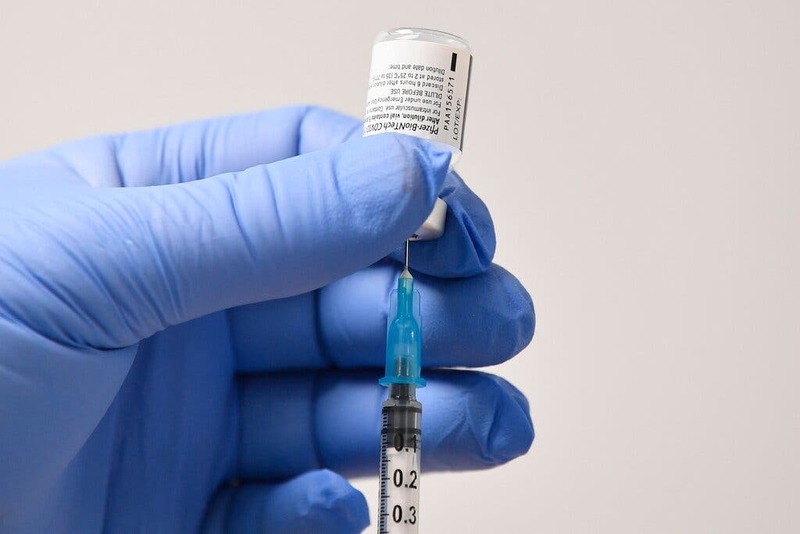
2020-12-14
The Food and Drug Administration authorized Pfizer’s Covid-19 vaccine for emergency use on Friday, clearing the way for millions of highly vulnerable people to begin receiving inoculations within days.
The authorization is a turning point in a pandemic that has taken more than 290,000 lives in the United States. With the decision, the United States becomes the sixth country — in addition to Britain, Bahrain, Canada, Saudi Arabia and Mexico — to clear the vaccine. Today, we ask the science and health reporter Donald G. McNeil Jr. what might happen next.
-
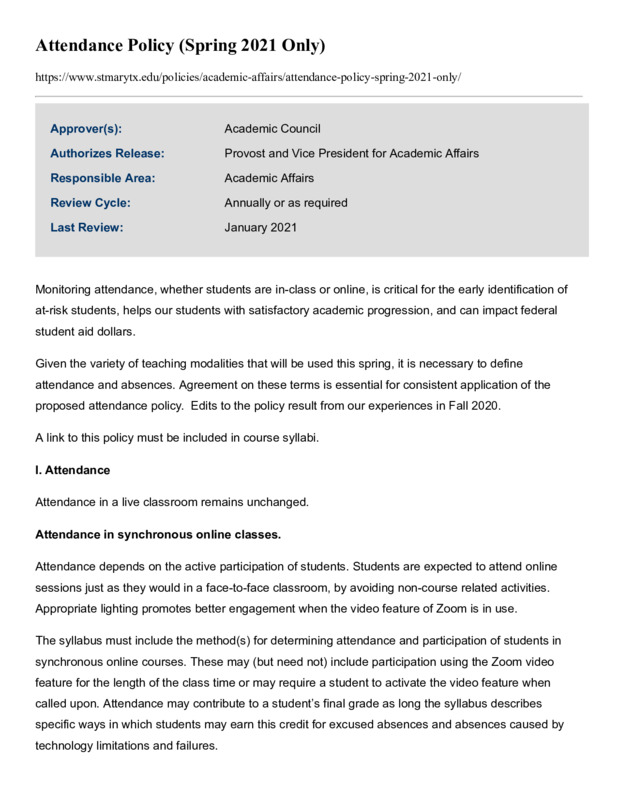
2021-01-10
Students slowly began to return to campus and in-person classes as we moved into the second full semester during COVID. While policies were still place for things such as masks and attendance, they became more lenient as COVID “lessened.” This goes to show how difficult it could have been for the people in the positions to make these decisions. Their decisions were based on the new information that was being released by public health officials throughout the pandemic.
-

2020-04-23
Many students from the start of the pandemic have had to turn to governmental assistance from the CARES act to help pay for their tuition or college-related expenses. This item showcases one of the most prominent government relief programs that were available to STMu students and college students nationwide. This funding was essential for many college-aged students who may not have qualified for the stimulus package or unemployment but who were facing the negative financial effects of the pandemic.
-
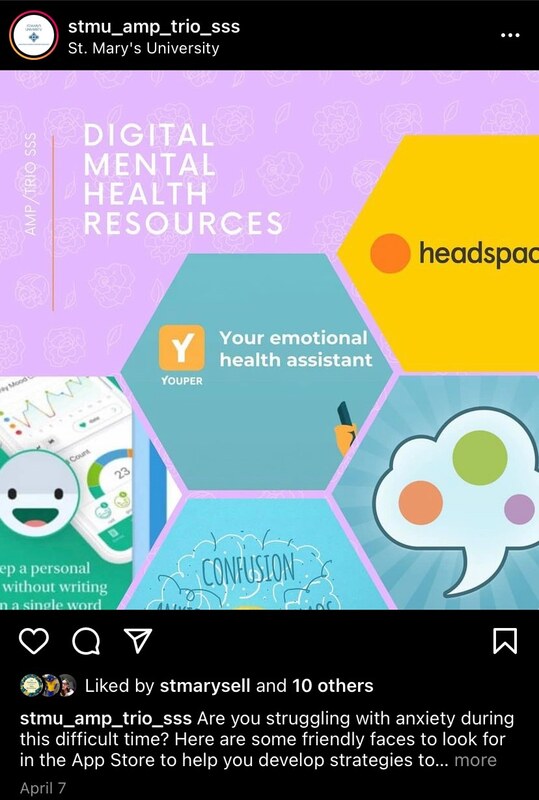
2021-04-07
The pandemic was difficult in more ways than one. Health and safety were covered by all news stations, but the deeper hidden pandemic was the struggle of mental health and staying mentally healthy during isolation and lockdown. These screenshots showcase that mental health was an important topic that people were struggling with but the university tried to give help to students and staff that were struggling. This screenshot is important to me because they were resources I utilized that helped me mentally go through the pandemic and I believe deserve more attention.
-

2021-11-01
When this series of emails was sent to St. Mary's Faculty and Staff it really hit hard and really touched me. I didn't realize that some students did not have any means of getting back home, students were not prepared for this at all and due to the pandemic all dorms and classes were cancelled, they were worried they would not make it home. So, St. Mary's sent an email out reaching out to everyone that was able to give funds and send students home. When this pandemic hit us no one was prepared for what was to come.
-
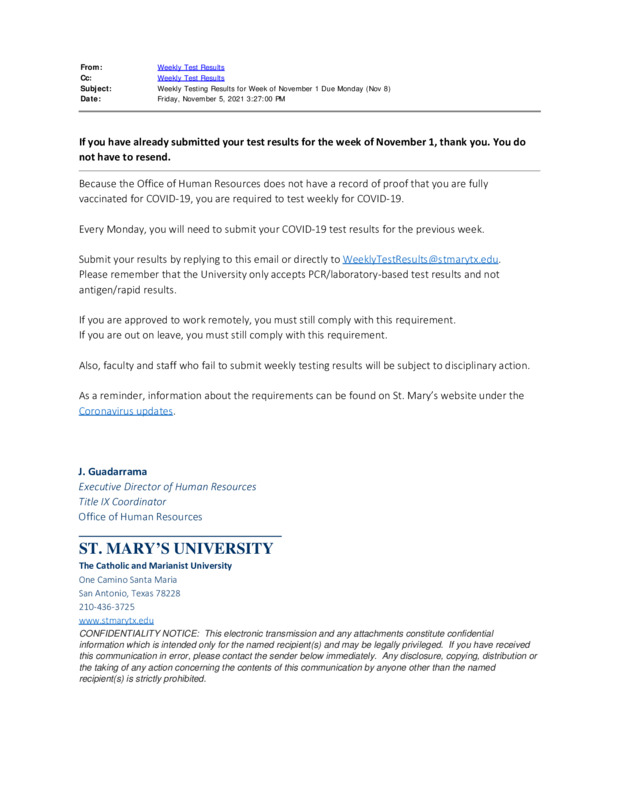
2021-11-10
Since the pandemic and everyone returning back to work a vaccine has been provided for everyone to take the vaccine if they choose to. The vaccine is to help with Covid, if received it can help with less symptoms if one happens to catch Covid. At my place of employment we have received emails from HR that anyone who has not been vaccinated must take a covid weekly test in order to ensure we do not have covid and make sure the campus is a safe place to be and ensure that everyone stays virus free.
-
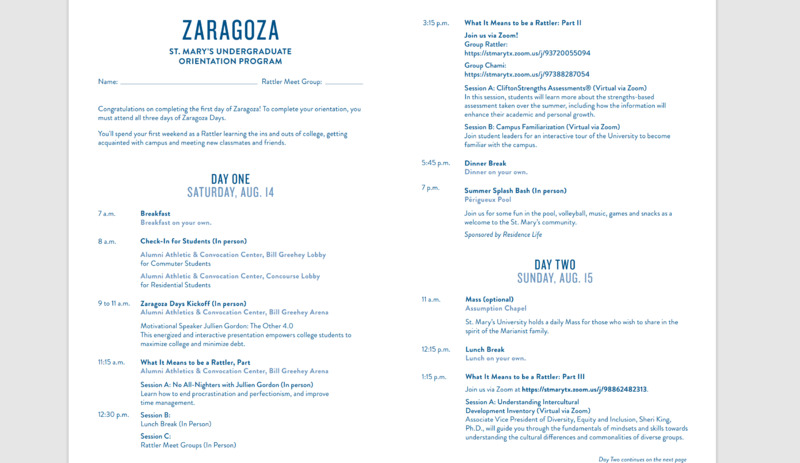
2021-08
This orientation program shows the different accommodations that have been made to ensure a safe experience during Zaragoza days. Prior to the pandemic, the events scheduled for students would be held in person so that students would have the opportunity to interact face to face and make new connections with other students. However, the Zaragoza days held in August 2021 integrated both in person and online orientation events. This program shows that some of the scheduled events were held on Zoom during different sessions. This was to ensure that students were provided with safe and easy access to learn more about being and undergrad at St. Mary's while not completely limiting their orientation experience by still holding in person events that adhered to Covid-19 guidelines.
-

2021-08
For this item, I wanted to highlight the differences in the Zaragoza student orientation for incoming freshmen and transfer students. This is a program that happens at the beginning of every school year. My class, entering St. Mary's in Fall 2019 was the last class to have a normal experience prior to the pandemic. However, since the pandemic, many operations have had to change to ensure the safety of those involved. The Fall 2020 Zaragoza experience was entirely over zoom. With the school now transitioning back to in person teaching, Zaragoza leaders had to the opportunity and challenge to create a Zaragoza experience like never seen before that provided safe interaction among all students and parents. These screenshots specifically showed a rushed project that needed to be approved in a short amount of time that accommodated both to the universities expectations while following the state's guidelines.
-
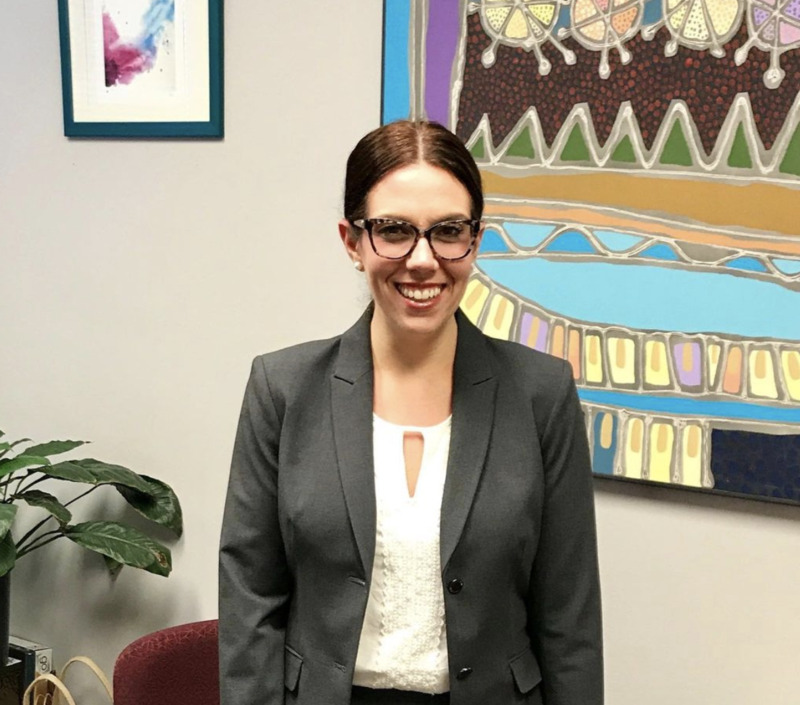
2021-11-03
Through this oral history, Clare Acosta and I develop a conversation about both the Community Engagement office work and the program of Empower: Ecuador. The conversation was specifically focused on the before and after of COVID-19 and also what was learned from the process. It is a very deep conversation that I really enjoyed and know that Clare also did.
-
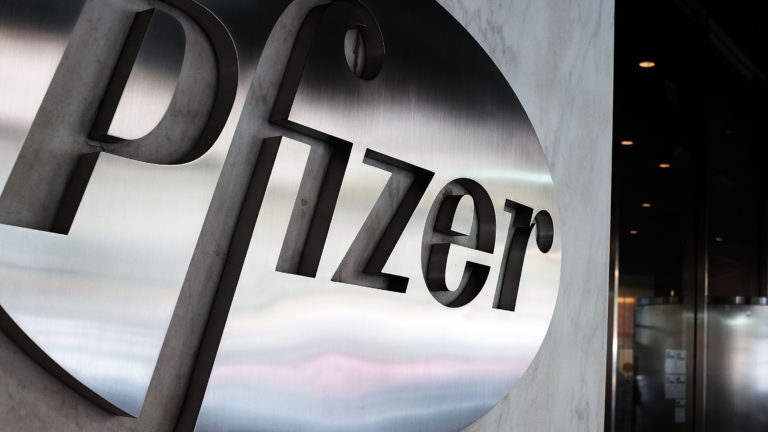
2020-09-14
Pfizer and BioNTech are moving to enlarge the Phase 3 trial of their Covid-19 vaccine by 50%, which could allow the companies to collect more safety and efficacy data and to increase the diversity of the study’s participants.
The companies said in a press release that they would increase the size of the study to 44,000 participants, up from an initial recruitment goal of 30,000 individuals.
The U.S. Food and Drug Administration will have to approve the change before it goes into effect.
“The companies continue to expect that a conclusive readout on efficacy is likely by the end of October,” the press release said. The Pfizer and BioNTech study is likely to be among the first in the U.S. to report efficacy data from a Phase 3 trial.
Related: AstraZeneca resumes Covid-19 vaccine trials in the U.K.
Expanding the trial will likely make it easier for the company to demonstrate whether the vaccine is effective against SARS-CoV-2, the virus that causes Covid-19. The companies also said that the change will allow the study to include a more diverse population. The companies said the study will now include adolescents as young as 16, people with stable HIV, and those with hepatitis C or hepatitis B.
The companies said that the trial is expected to reach its initial target of 30,000 patients next week. Moderna, which started its trial on the same day as Pfizer, said on Sept. 4 that it is working to increase the diversity of trial participants in its study, “even if those efforts impact the speed of enrollment.”
Related: Covid-19 Drugs and Vaccines Tracker
The Pfizer/BioNTech study could finish sooner than Moderna’s, even though the two began on the same day, for other reasons, as well. Both vaccines require a second shot; Pfizer’s is given after three weeks, while Moderna’s is given after four. The Pfizer trial also starts to count cases of Covid-19 sooner after participants receive their shots than the Moderna study.
But the Pfizer/BioNTech vaccine could also prove to be one of the most difficult of the experimental vaccines to distribute, should they prove effective. The vaccine must be kept at a temperature of -70 degrees Celsius.
There has been political pressure to move a vaccine quickly, with President Trump saying that one could be available before election day. Last week, several drugmakers, including Pfizer, issued a pledge not to move a vaccine forward sooner than was justified by the results of their clinical trials.
-
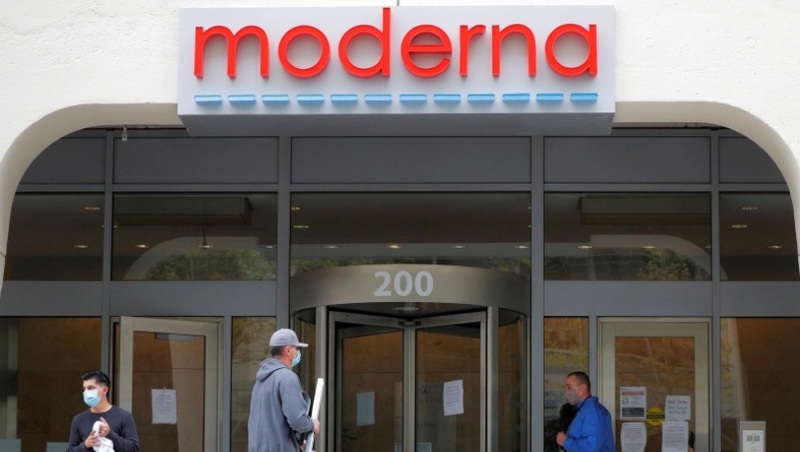
2020-07-14
Moderna Inc’s experimental vaccine for COVID-19 showed it was safe and provoked immune responses in all 45 healthy volunteers in an ongoing early-stage study, U.S. researchers reported on Tuesday.
Volunteers who got two doses of the vaccine had high levels of virus-killing antibodies that exceeded the average levels seen in people who had recovered from COVID-19, the team reported in the New England Journal of Medicine.
No study volunteers experienced a serious side effect, but more than half reported mild or moderate reactions such as fatigue, headache, chills, muscle aches or pain at the injection site. These were more likely to occur after the second dose and in people who got the highest dose.
Experts say a vaccine is needed to put an end to the coronavirus pandemic that has sickened millions and caused nearly 575,000 deaths worldwide.
Moderna was the first to start human testing of a vaccine for the novel coronavirus on March 16, 66 days after the genetic sequence of the virus was released.
Dr. Anthony Fauci, director of the National Institute of Allergy and Infectious Diseases, whose researchers developed Moderna’s vaccine candidate, called the results “good news,” noting that the study found no serious adverse events and the vaccine produced “reasonably high” levels of virus-killing or neutralizing antibodies.
“If your vaccine can induce a response comparable with natural infection, that’s a winner,” Fauci said in a telephone interview. “That’s why we’re very pleased by the results.”
Moderna shares jumped more than 15% in after-hours trading on Tuesday.
The U.S. government is supporting Moderna’s vaccine with nearly half a billion dollars and has chosen it as one of the first to enter large-scale human trials. A successful vaccine could be a turning point for Cambridge, Massachusetts-based Moderna, which has never had a licensed product.
Moderna’s shot, mRNA-1273, uses ribonucleic acid (RNA) - a chemical messenger that contains instructions for making proteins. When injected into people, the vaccine instructs cells to make proteins that mimic the outer surface of the coronavirus, which the body recognizes as a foreign invader, and mounts an immune response against.
The results released Tuesday involved three doses of the vaccine, tested in groups of 15 volunteers aged 18-55 who got two shots, 28 days apart. The groups tested 25, 100 or 250 micrograms of the vaccine.
Adverse events after the second dose occurred in seven of the 13 volunteers who got the 25-microgram dose, all 15 participants who received the 100 microgram dose and all 14 who got the 250 microgram dose. In the highest-dose group, three patients had severe reactions such as fever, chills, headache or nausea. One of these had a fever of 103.28 Fahrenheit (39.6 C).
“We didn’t see any events that are characterized as serious adverse events,” said lead author Dr Lisa Jackson of Kaiser Permanente Washington Health Research Institute in Seattle, referring to reactions that require hospitalization or result in death.
In June, Moderna said it selected the 100-microgram dose for its late-stage study to minimize adverse reactions.
At that dose, Moderna said the company is on track to deliver about 500 million doses per year, and possibly up to 1 billion doses per year, starting in 2021, from the company’s internal U.S. manufacturing site and strategic collaboration with Swiss drugmaker Lonza.
“It’s a good first step,” said Dr William Schaffner, a vaccine expert at Vanderbilt University Medical Center who was not involved in the study.
“There’s nothing here that would inhibit one from going ahead to the Phase 2/Phase 3 trials,” he said.
In April, Moderna expanded the Phase 1 trial to include adults over 55, who are more at risk of serious disease, with the aim of enrolling 120 volunteers. Moderna said it will follow study volunteers for a year to look for side effects and check how long immunity lasts.
Moderna started its phase 2 trial in May and expects to start a phase 3 trial on July 27.
Phase 1 trials aim to ensure a treatment is safe and help determine an effective dose. Phase 2 trials test a treatment in a larger group and get an early read on effectiveness. Phase 3 trials are conducted in a large group of individuals to confirm efficacy and identify rare side effects. Moderna’s Phase 3 trial will be conducted in 30,000 volunteers.
-
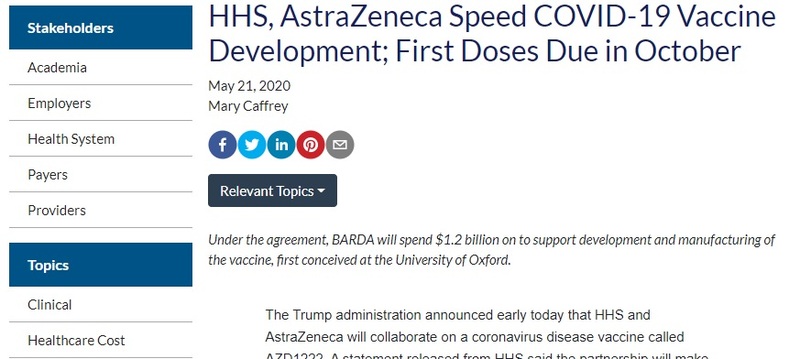
2020-05-21
The Trump administration announced early today that HHS and AstraZeneca will collaborate on a coronavirus disease vaccine called AZD1222. A statement released from HHS said the partnership will make “at least 300 million doses” of the vaccine available, “with the first doses delivered as early as October 2020.”
The vaccine is one originally developed at the University of Oxford; the university and AstraZeneca announced a global development agreement for the vaccine on April 30. In its own statement early today, AstraZeneca said a phase 1/2 clinical trial of the vaccine began last month to assess its safety immunogenicity and efficacy in over 1000 healthy volunteers, who are 18 to 55 years of age. These volunteers are all in the United Kingdom. Late-stage trials would begin in several countries based on these results, the statement said.
According to HHS, the agreement between AstraZeneca and the Biomedical Advanced Research and Development Authority (BARDA), an agency within HHS, would essentially kick start manufacturing of the doses while phase 3 clinical studies are under way this summer, involving 30,000 volunteers in the United States. BARDA will spend up to $1.2 billion for research, technology transfer, and scaled-up manufacturing,
Emergency use authorization or licensure from FDA would be needed for the vaccine to reach the public, the statement said. As for the timeline, “Early milestones enable BARDA and AstraZeneca to determine how the program progresses forward.”
“This contract with AstraZeneca is a major milestone in Operation Warp Speed’s work toward a safe, effective, widely available vaccine by 2021,” said HHS Secretary Alex Azar. “Getting a vaccine to the American public as soon as possible is one part of President Trump’s multi-faceted strategy for safely reopening our country and bringing life back to normal, which is essential to Americans’ physical and mental well-being in so many ways.”
“The Trump Administration is making multiple major investments in developing and manufacturing promising vaccines long before they’re approved so that a successful vaccine will reach the American people without a day wasted,” Azar said.
Besides the BARDA agreement, AstraZeneca said it has reached deals with the Coalition for Epidemic Preparedness Innovations (CEPI), the Vaccine Alliance and the World Health Organisation (WHO), to ensure the fair allocation and distribution of the vaccine around the world. AstraZeneca is also in discussions the Serum Institute of India and other potential partners to boost production and distribution.
AstraZeneca also holds a major stake in Moderna Therapeutics, which announced earlier this week its experimental vaccine had produced antibodies in small group of healthy volunteers.
-
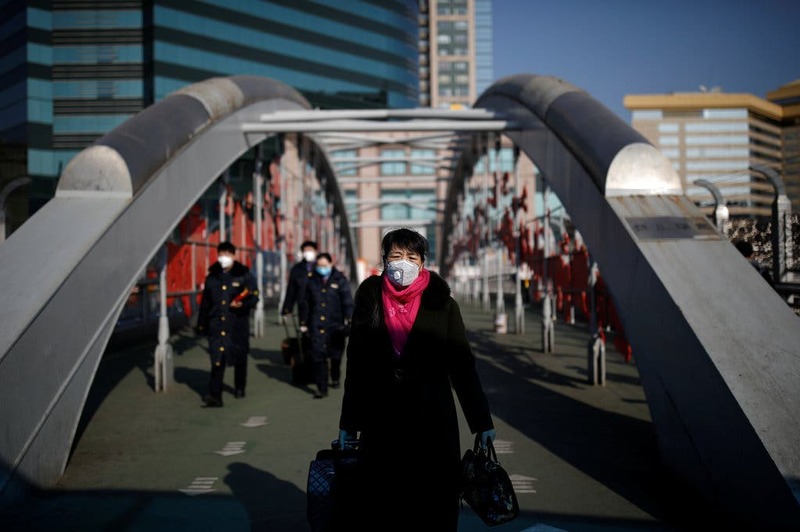
2020-01-30
The World Health Organization declared a global health emergency on Thursday as the coronavirus outbreak spread well beyond China, where it emerged last month.
The move reversed the organization’s decision just a week ago to hold off such a declaration. Since then, there have been thousands of new cases in China and clear evidence of human-to-human transmission in several other countries, including the United States.
-
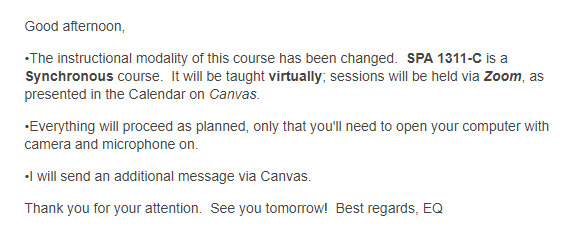
2021-08-17
For Fall 2021, some teachers gave the option to zoom into class for students who were not comfortable being present in person. Out of my five classes, only two had this option specifically stated. I planned to attend all classes in person but the day before class was due to start one teacher switched to remote only. Initially, I was okay with it. It was the first class of the day so maybe I wouldn't have to get up so early. Then I realized I would have to wake up early anyway. The class after the remote one was ten minutes after. I would of had to rush even if the class was on campus. Situations like these showed that things were even unexpectedly changing for teachers. While the situation may have slightly inconvenienced me, I'm sure it wasn't ideal for the teacher either.
-
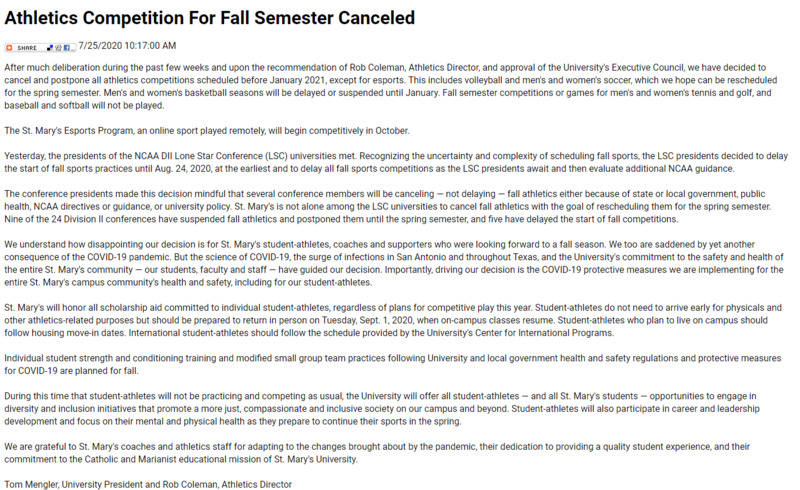
2020-07-25
Athletics has always been a big part of bringing together a school's community. It's an important aspect for not just the athletes but also the supporters. The complete cancellation of sporting events can be a jarring disruption to a school's morale and spirit. The rising of popularity of esports and competitive videogames though has been helpful in keeping people connected. Though physical, in person sports have been cancelled, classmates can still keep in touch with each other through their school's team by playing and watching the school's online games. The St. Mary's esports team has provided a way for people for people with similar interests to meet without actually ever seeing each other in person. A placement on the team isn't even necessary. Videogames have been an important outlet for me in the pandemic to keep me mentally happy. The closure of many places and the inability to see certain people in real life has made me rely on them instead.
-
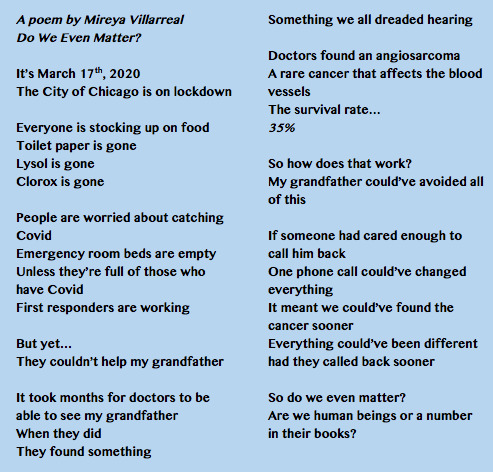
2021-10-26
This poem talks about the failure of our medical field when it came to covid. They focused more on those with Covid than those who were struggling with cancer. My grandfather became one of those victims.
-
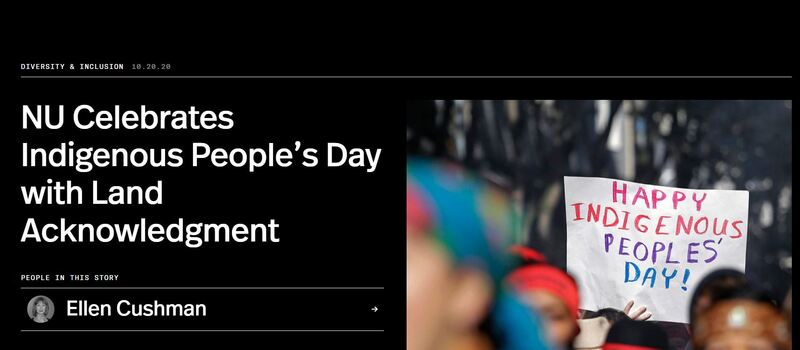
2020-10-20
Article regarding virtual Indigenous People's Day.
-
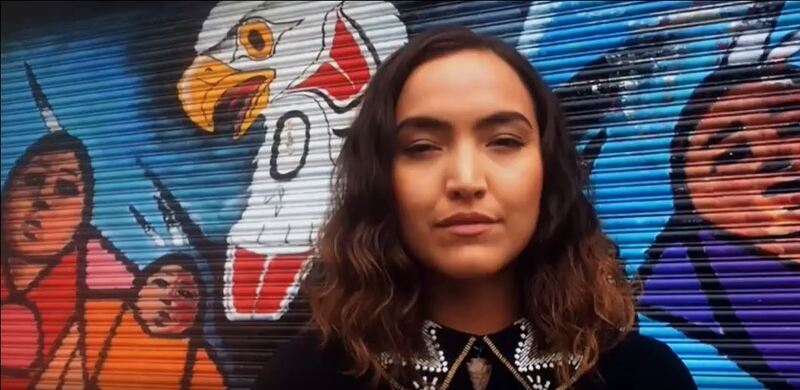
2021
This is a video on being Indigenous by CBC News.
-
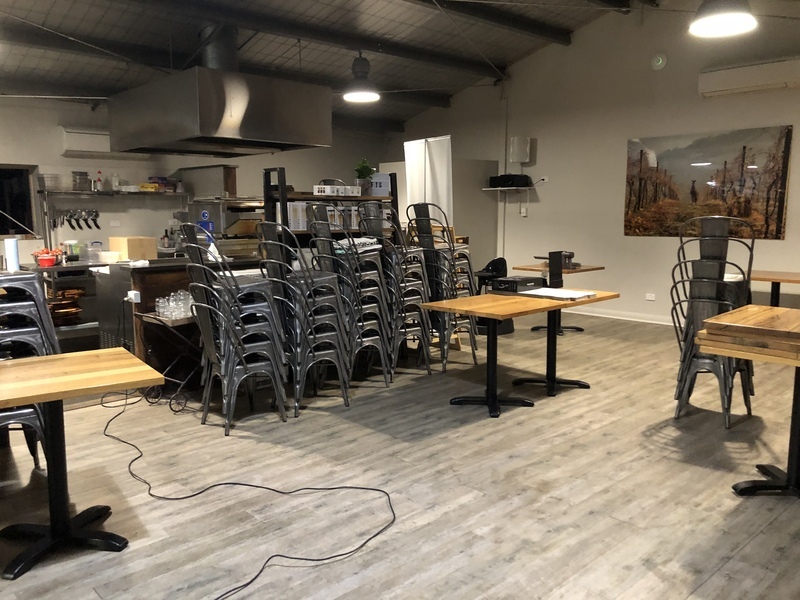
2021-10-09
My parents own a small restaurant, and as such, were largely impacted by Melbourne’s various lockdowns. The restaurant is located on the outskirts of the Yarra Valley, in a peri-urban region known for tourism. As such, the location of the restaurant is isolated from major townships and shopping complexes. We were open for takeaway at the start of the pandemic, however when the 5km rule was introduced (in metropolitan Melbourne residents were only allowed to travel a maximum of 5km from home) it meant that only our very near neighbours were permitted to pick up takeaway; remaining open was thus unviable. As we transition into a post-COVID world, my Mum – the manager – in consultation with other local restaurant owners has reflected on common anxieties about the spread of COVID-19 and the process of verifying/mandating that each customer is double vaccinated (as per state government legislation). Will we receive resistance from anti-vaxxers? Will these rules impact how many customers we receive? There are many unknowns. Pictured is the interior of the restaurant – which has been packed up for nearly a year now – and our check-in QR code which customers must scan before entering.
-
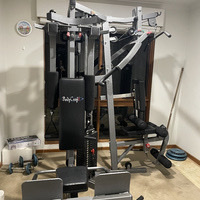
2021-06-06
Exercise became a large part of my life in the pre-pandemic world. It assisted me in maintaining good mental and physical health whilst I navigated university life, work life and social life. I signed up to a gym and regularly attended group fitness sessions. Having found this therapeutic outlet, my anxiety flared up when gyms were closed at the start of the pandemic. I think that many people, like me, would have struggled with the inability to undertake their fitness regimens – for social, physical or mental health purposes – during the pandemic. My Dad was also one of these people – he went out and bought a home gym for us to use (which we crammed into our spare room). In 2021, I thought the pandemic was over, however was still very appreciative of the set of dumbbells I received for my birthday. Sure enough, we were back into a lockdown soon after. Thank goodness for those dumbbells – they’ve kept me sane, more than I’d like to admit!
-
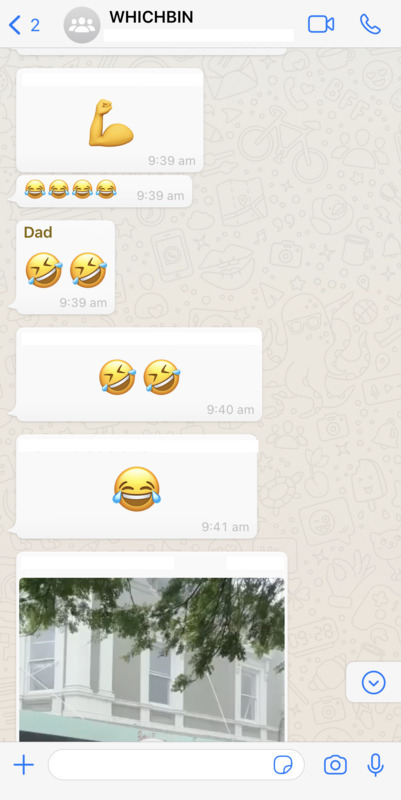
2021-09-10
Lockdown shifted the nature of community dynamics in our local area. We live in a peri-urban region on the outskirts of the Yarra Ranges; as such, neighbouring properties are separated by large swathes of Australian bush. This can be isolating at times; it’s very different to suburban living. Our street (which spans about 7kms) and adjacent streets have a WhatsApp group chat named ‘Fireguard’, which allows residents to share information about fire safety, planned burn-offs and emergency warnings. However, during lockdown the chat was increasingly used for the purposes of socialisation. Suddenly, distant neighbours began sharing jokes and engaging in conversations about lockdown living, through the chat. The chat became a site of social interaction that the members of our area probably didn’t realise they needed, until they did. We eventually decided to create a separate chat for general/social purposes only, the title ‘WHICHBIN’ constituting a friendly inside joke about one particular chat member who never fails to ask, “which bin?” she needs to put out for collection each week.
-
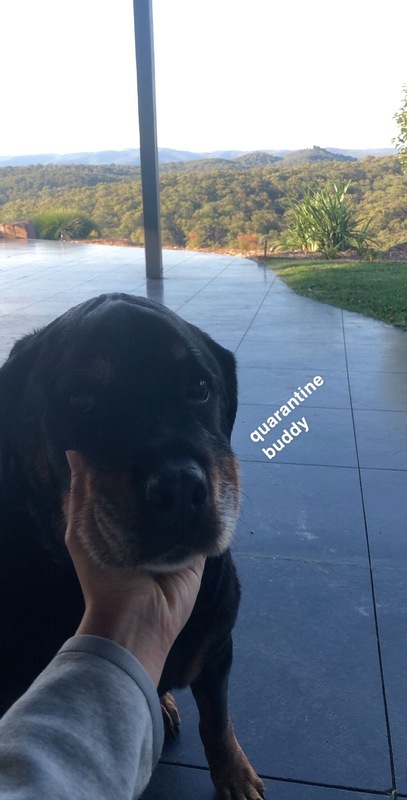
2020-12-18
State-sanctioned restrictions changed the way in which individuals/groups were able to process emotional experiences, such as grief. Our family dog –Bonnie – was a saving grace during lockdown. She was my “quarantine buddy” and made each day a little brighter. My family went through a tough time around Christmas; Bonnie was becoming progressively sicker, and we had to make the decision to put her down. When we arrived at the vet clinic, we discovered that our family who had attended – Dad, Mum, my brother, myself and my grandparents – could not all wish her farewell together; only two of us were allowed in the waiting room with Bonnie at once, due to COVIDSafe density limits. My parents went in together, and then my grandparents, and then my brother and myself. I’m glad that my brother and I got to share the experience of saying goodbye together; Bonnie was a fundamental part of our childhoods, thus we shared a similar type of grief. However, the ability to farewell this member of our family as a family unit was impacted by COVID-19. Pictured is a “Snapchat” of Bonnie that I sent to my friends, and a picture of her at the clinic.
-
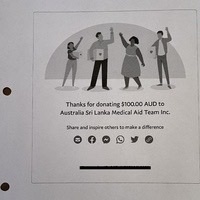
2021-05-06
Through discussions with my grandmother, I reflected on an interesting intersection between the impact of the lockdown on both older Melburnians and faith communities. My grandmother is a practising Buddhist; a key annual ritual that was unable to be undertaken in 2021 was the commemoration of my grandfather’s death anniversary, typically observed by preparing food and inviting friends and relatives to our home for a ceremony (known in Buddhist ethics as sharing ‘merits’ with the deceased to send them good fortune). As this gathering was not permitted, my grandmother shared ‘merits’ with my grandfather by instead donating to a charity; I think that such as example highlights the mediation between religious practices and natural sciences, in the context of this health crisis. Pictured is the receipt from my grandmother’s donation; sharing her wealth by committing this good deed was important to her during this time.
-

2020-03-27
During the height of the pandemic and quarantine, my family and I spent hours a day walking. We would walk through our neighborhood, the Metroparks, and we would find new trails and paths. One day they made an announcement that the country would be in quarantine for another month. my family and I were concerned and didn’t know what to expect. We were thinking how much longer can this be, what is our world coming to, and will everyone stay safe. we were unsure of our future. we decided to take a walk to clear our minds. During the walk, we came up to sidewalk chalk that said be positive with handprints, hearts, and other creative designs. It was a young girl who was designing these patterns and quotes and it made us realize that we need to stay positive during these tough times. It was a day we all remember during quarantine.
-
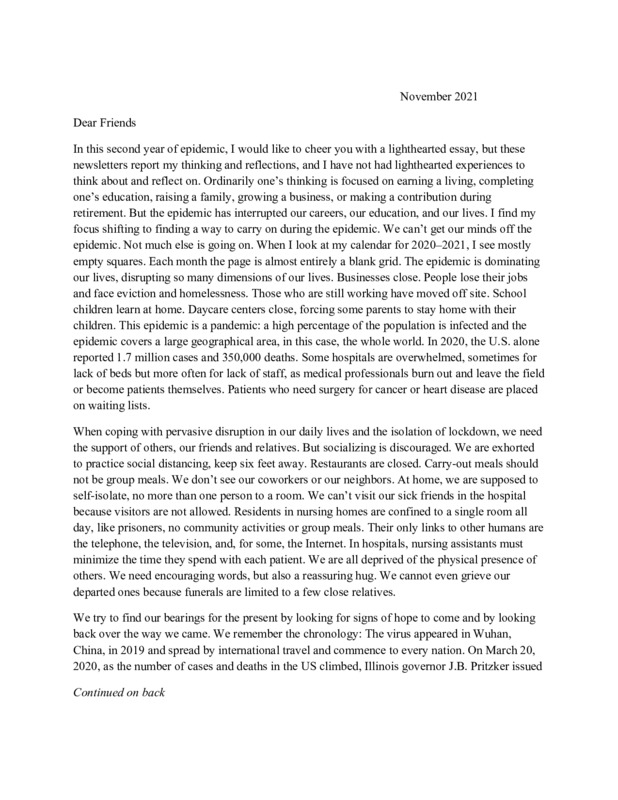
2021-11-03
At the holidays I send a newsletter about whatever I have been thinking that year. This year and last the newsletters were about the epidemic. I was looking for examples in history to help us see today how we could cope with the disruption of our lives.
-
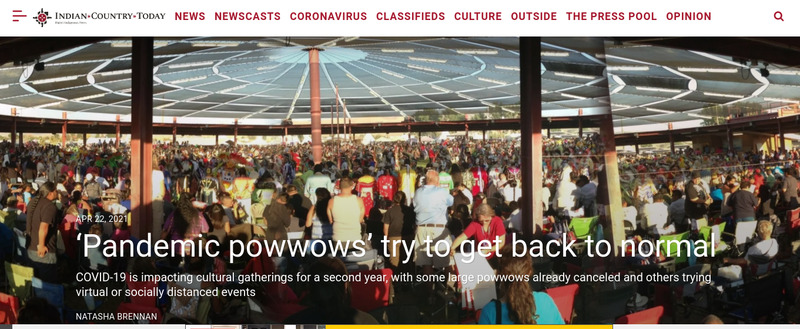
2020-09-14
Every year as a tradition Tribes of Native Americans gather to celebrate through song and dance at events known as Pow Wows. These events reinforce long-honored traditions, the most important being unification. The Pow wows allow for the togetherness of the people and the connectedness of the tribes. Covid -19 brought an abrupt halt to that for hundreds of indigenous tribes across the U.S and Canada. As a result, the only way to share some of these meaningful traditions was to offer a virtual option. While not the same it did allow for some of the singing and dancing competitions to take place. The long-term after effect though is that not having the in-person Pow Wow resulted in a significant loss of revenue for those tribes that were hosting the event. Pow Wows bring in significant revenue from vendors and non-indigenous spectators. This loss has had a trickle-down effect on the indigenous communities making it more difficult to endure the pandemic. As a parent of a Northeastern student, not having the ability to have my daughter physically share in the in-person powwows is disappointing. Pow wows are more than just celebrations they are an opportunity to connect with your identity and heritage-which is vital for the younger generations.
-
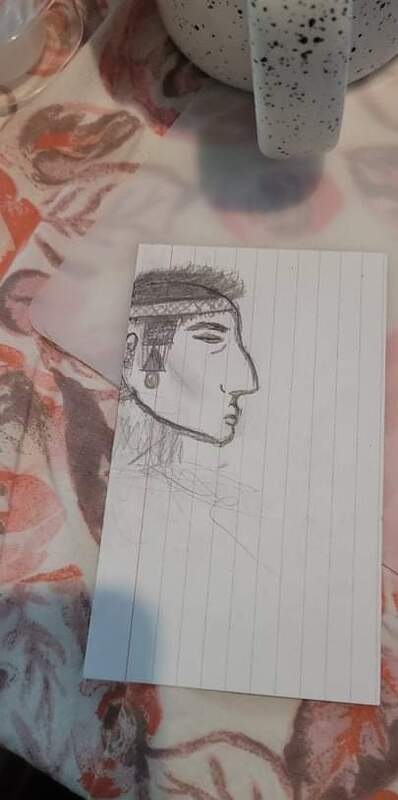
2020-03
I am a Game Art major at Full Sail University, but my sister goes to Northeastern University, so we are a Northeastern family. I am of Mayan descent, so living through COVID-19 was a little scary because we got all the news and updates about how COVID-19 was ravaging Mayan communities in Guatemala. We live in the USA in a rural area, so we were a little "safer," but the fear remained. I am proud of my people and my heritage, and I don't doubt our ability to survive the pandemic. Here is a quick sketch I made.
-

2020-06-30
After being sent home during Spring 2020 the Office of Residence Life changed the way it functioned. With that, student staff like resident assistants also had to change how they did their jobs. Creating community, health and safety checks, and engagement opportunities were all completed virtually. As many discovered, going to college via zoom came with many difficulties. What about when campuses were opening back up? What about the uncertainties regarding the growing pandemic after Spring 2020? In preparation for Fall 2020 and anticipation of re-opening residence halls, policy changes were made. Students were also asked to join the "Protect St. Mary's Pledge", a commitment to holding ourselves and our community accountable, ensuring we take the necessary precautions and follow policy. The Office of Residence Life and resident assistants were at the forefront of enforcing these new policies and keeping dorm halls safe. Resident assistants played a significant role in trying to make campus and residence life a bit normal again by creating community and engaging with residents, this time while taking covid-19 precautions. In a time of great transition and uncertainty, resident assistants served as student health ambassadors and vessels for the University's mission and policies.
-
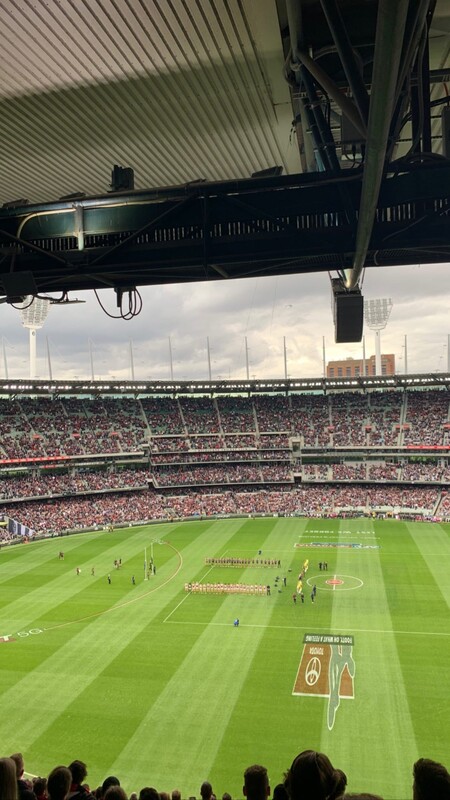
2021-04-25
This is an image from the Anzac Day match at the MCG on the 25th of April 2021. Returning to the MCG for AFL matches was one the more ‘normal’ things we could do at the start of the year. When this game was held, it was the largest crowd recorded at a sporting event in the world. The Anzac round is my favourite round of the year and it felt amazing that footy was back and Melbourne was covid free. A couple weeks later the AFL team I support - the Collingwood Magpies - saw its lowest ever recorded attendance at the MCG since 1940, as AFL returned, many of their supporters chose not to attend games, this may be due to how our team was performing or the capacity limits. Just looking back at this photo in lockdown makes me question how we thought we were ‘back to normal’ at the start of the year, when we were so far from it.
 2021-11-17
2021-11-17 2020-08-12
2020-08-12 2020-08-11
2020-08-11 2021-10-18
2021-10-18 2020-10-15
2020-10-15 2019-10-06
2019-10-06 2021-10-01
2021-10-01 2021-05-25
2021-05-25 2021-03-26
2021-03-26 2021-03-26
2021-03-26 2021-11-13
2021-11-13 2021-02-26
2021-02-26 2021-11-10
2021-11-10 2021-09-16
2021-09-16 2021-11-11
2021-11-11 2020-06-30
2020-06-30 2020-05-13
2020-05-13 2021-08-05
2021-08-05 2021-04-06
2021-04-06 2021-01-19
2021-01-19 2020-12-31
2020-12-31 2020-12-14
2020-12-14 2021-01-10
2021-01-10 2020-04-23
2020-04-23 2021-04-07
2021-04-07 2021-11-01
2021-11-01 2021-11-10
2021-11-10 2021-08
2021-08 2021-08
2021-08 2021-11-03
2021-11-03 2020-09-14
2020-09-14 2020-07-14
2020-07-14 2020-05-21
2020-05-21 2020-01-30
2020-01-30 2021-08-17
2021-08-17 2020-07-25
2020-07-25 2021-10-26
2021-10-26 2020-10-20
2020-10-20 2021
2021 2021-10-09
2021-10-09 2021-06-06
2021-06-06 2021-09-10
2021-09-10 2020-12-18
2020-12-18 2021-05-06
2021-05-06 2020-03-27
2020-03-27 2021-11-03
2021-11-03 2020-09-14
2020-09-14 2020-03
2020-03 2020-06-30
2020-06-30 2021-04-25
2021-04-25